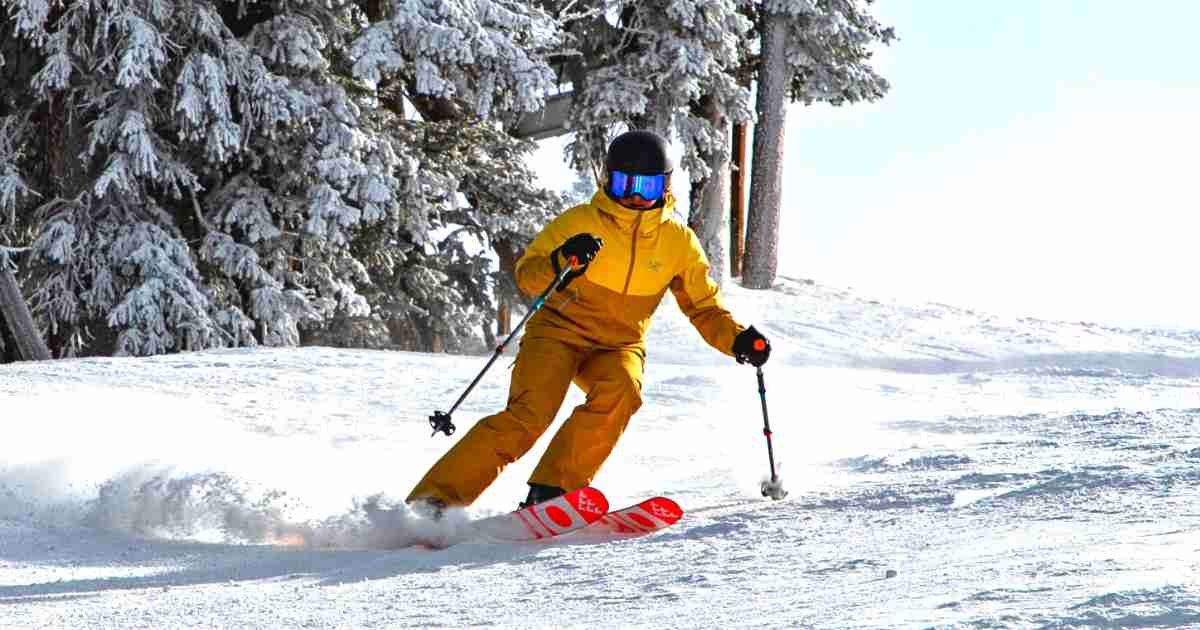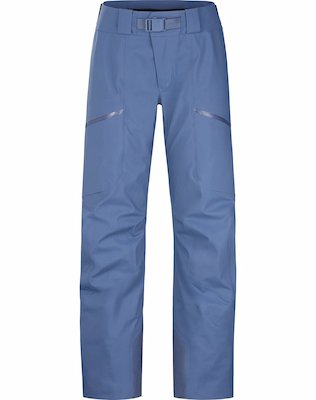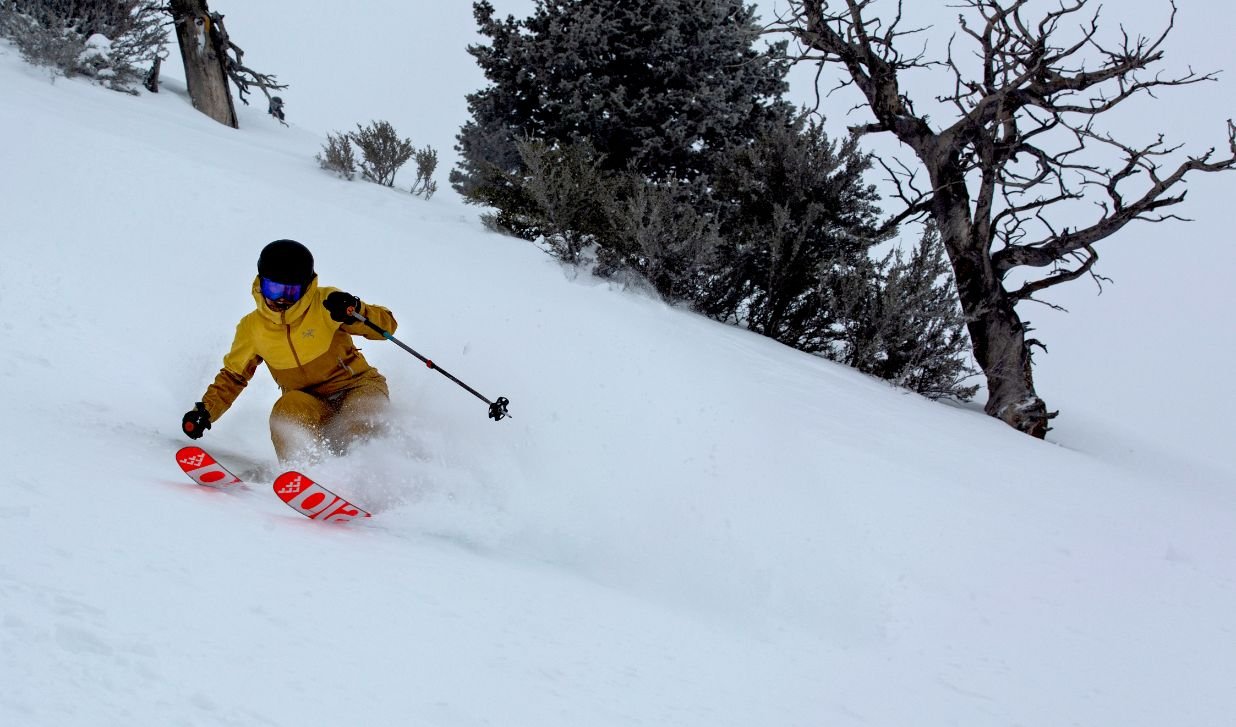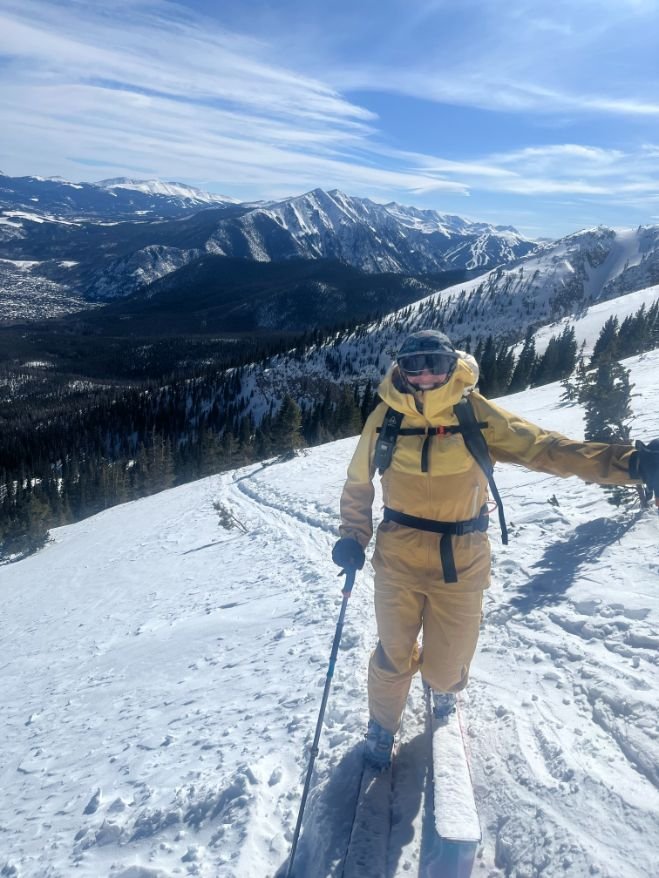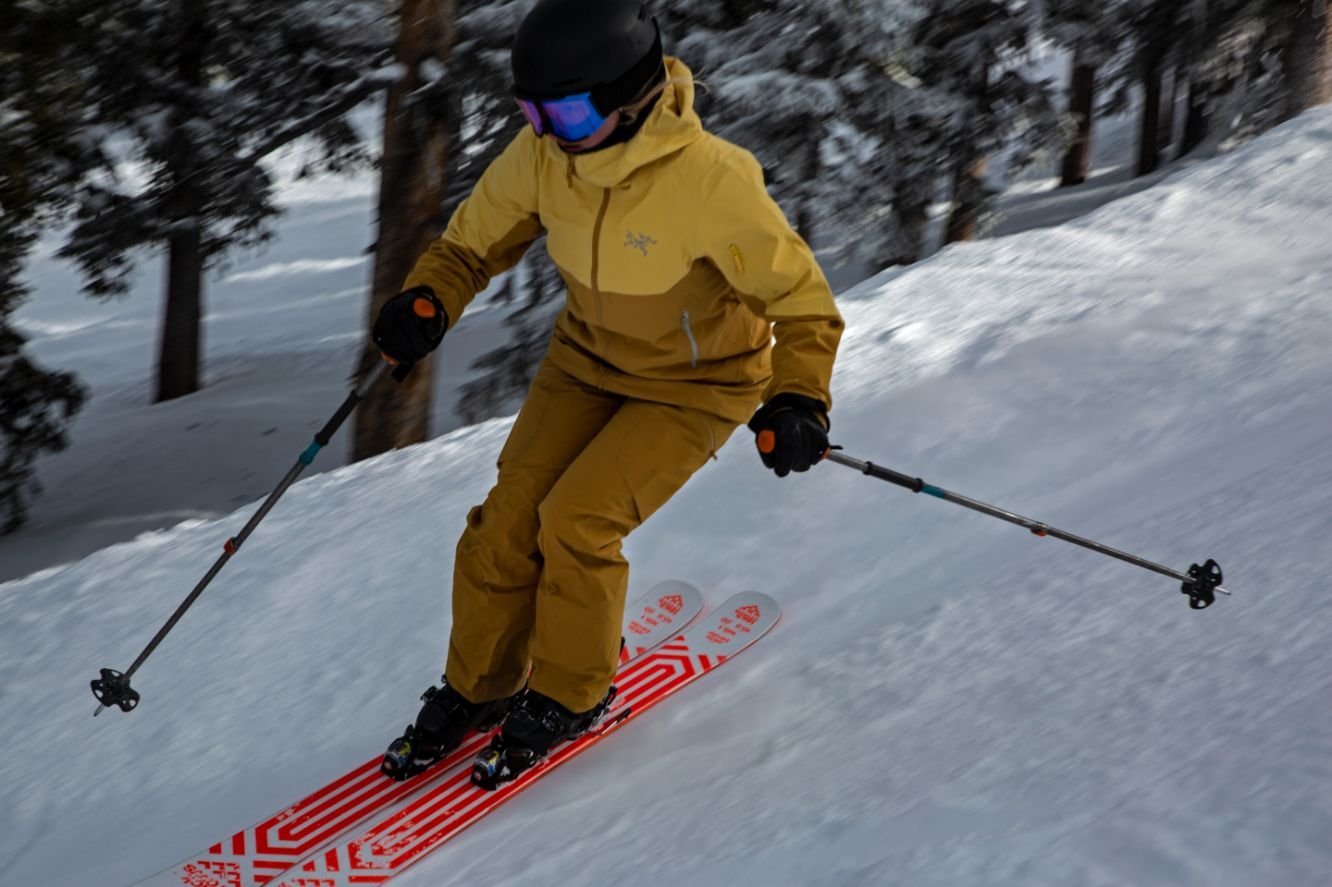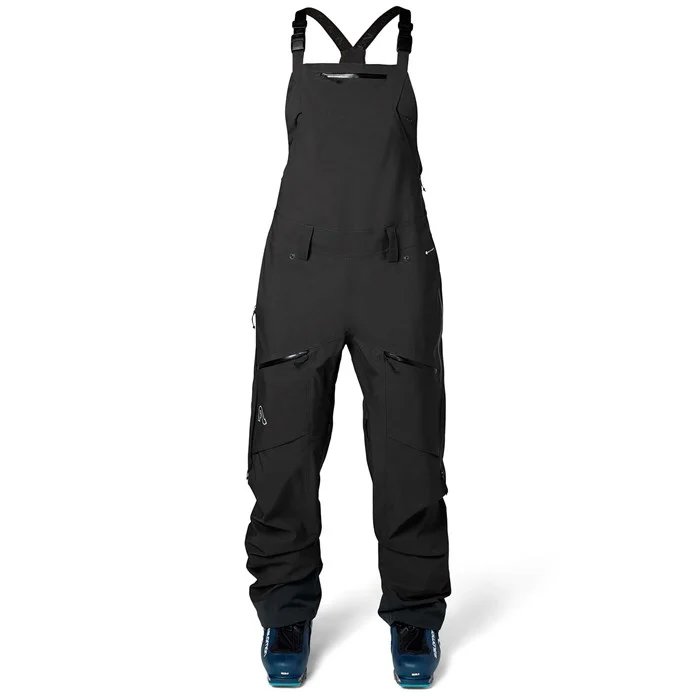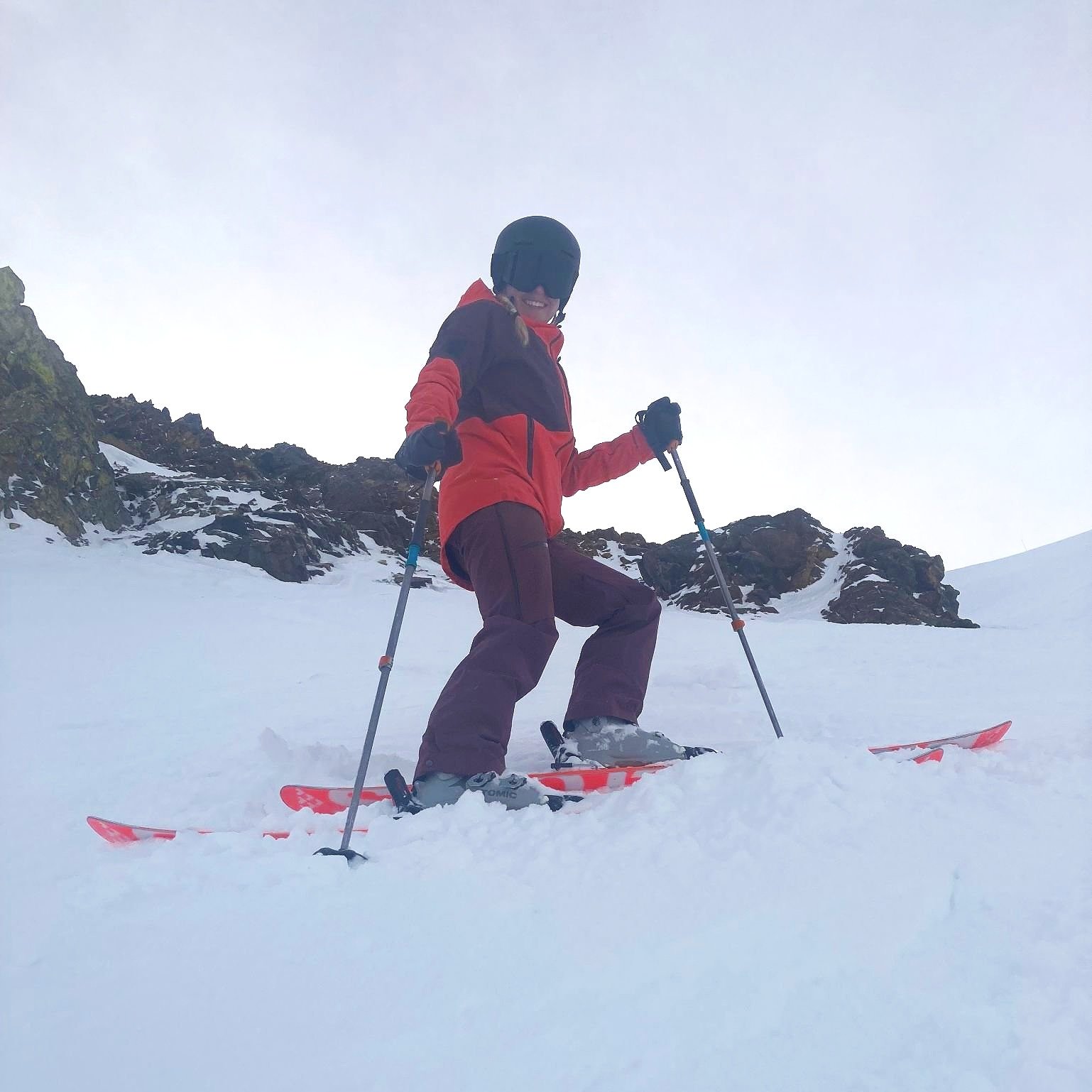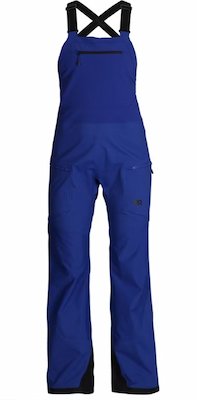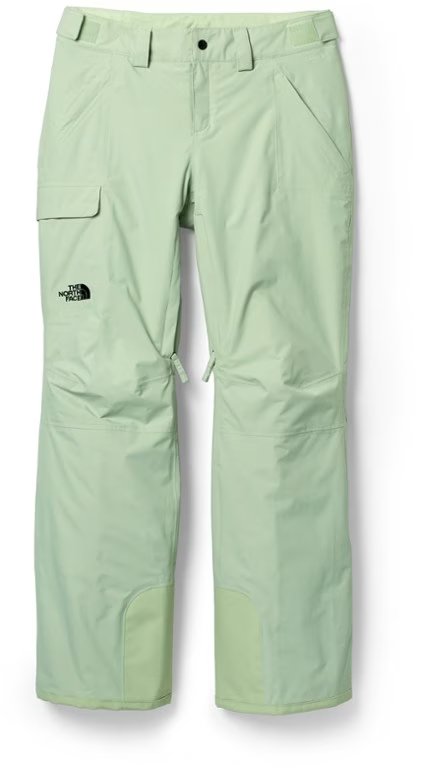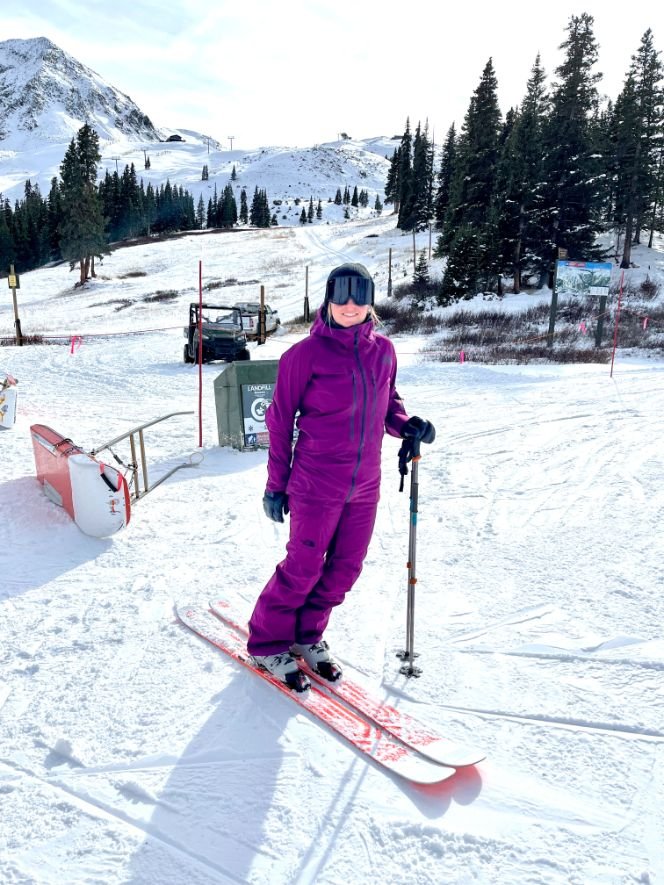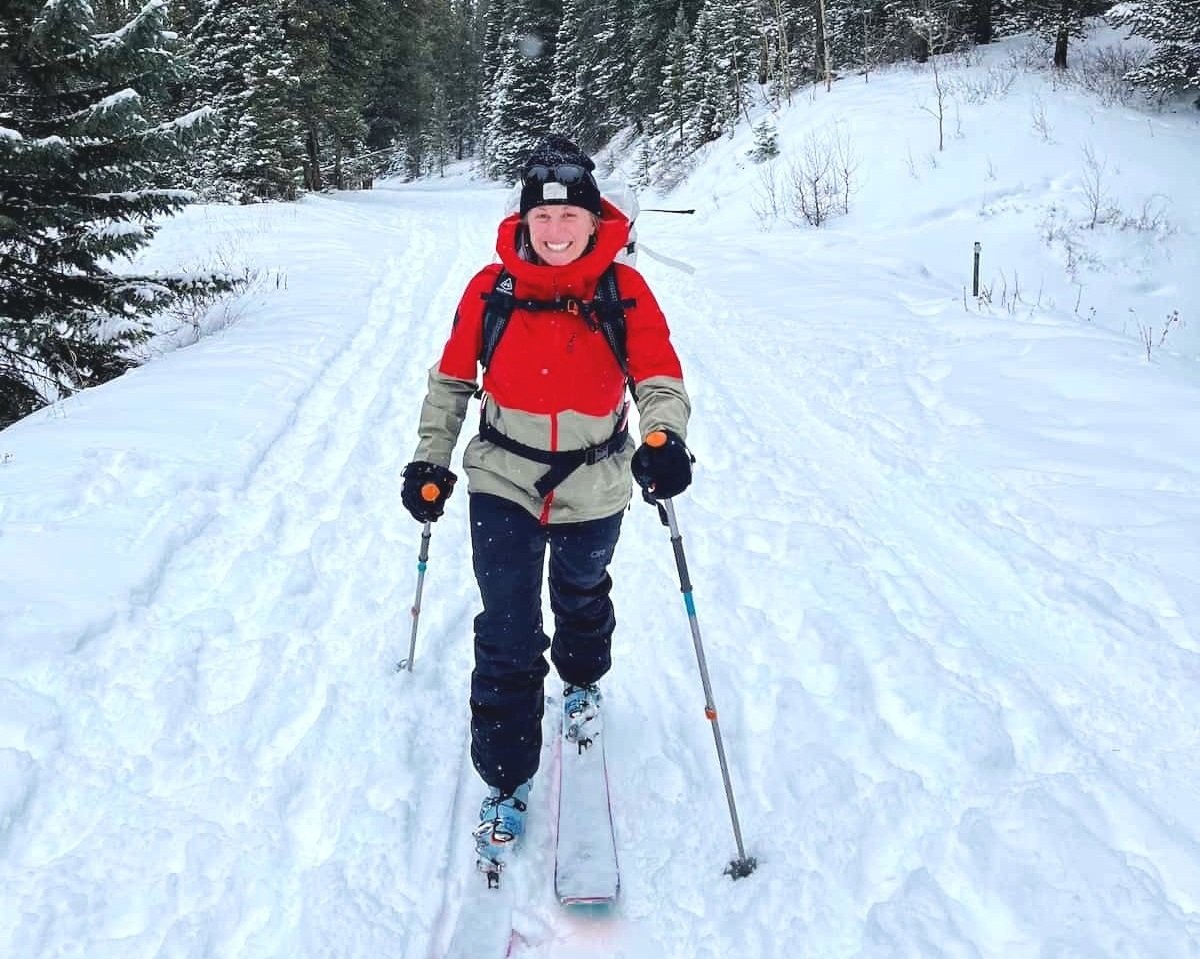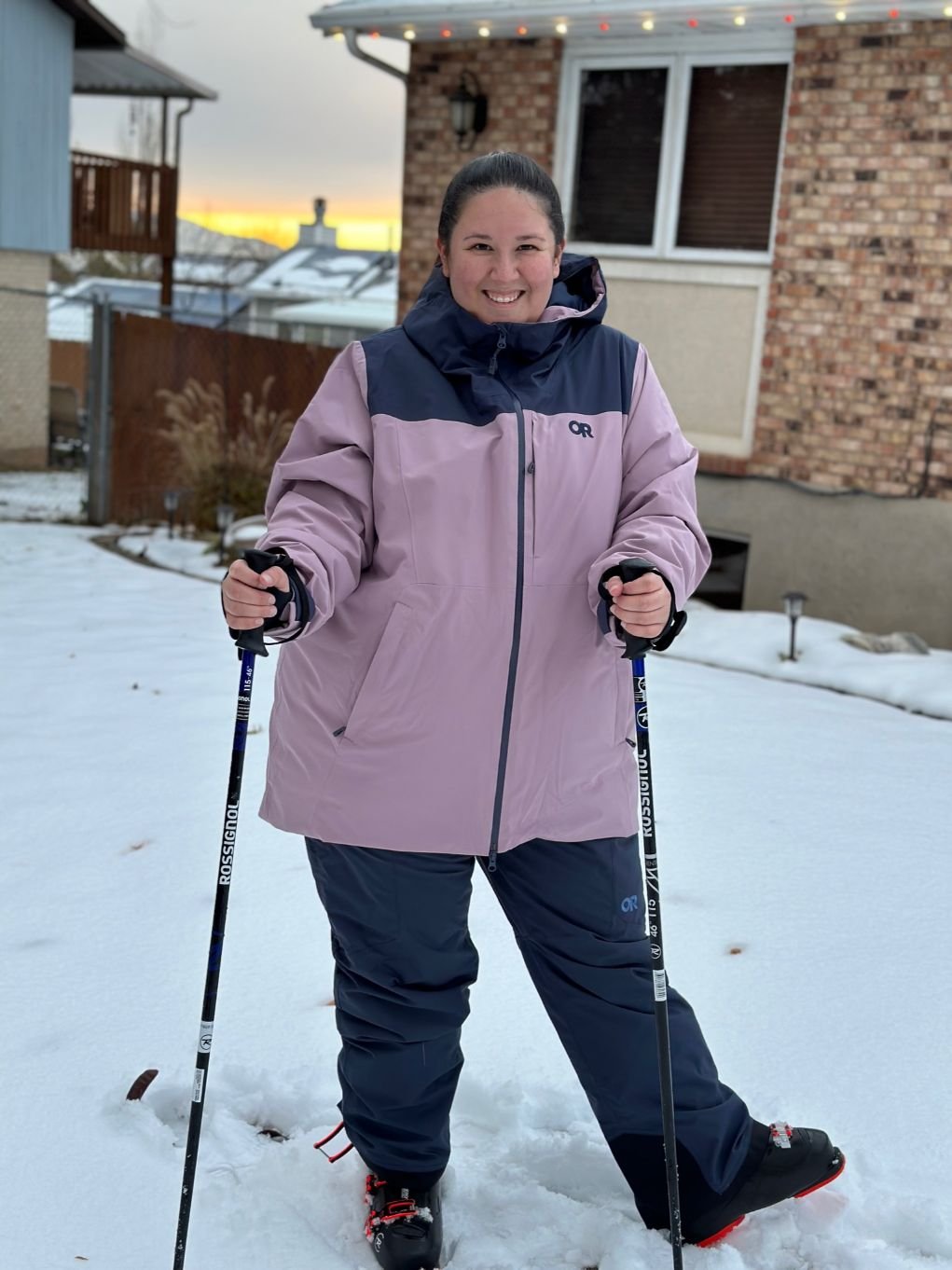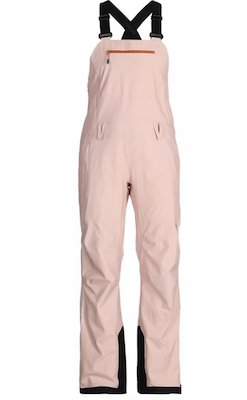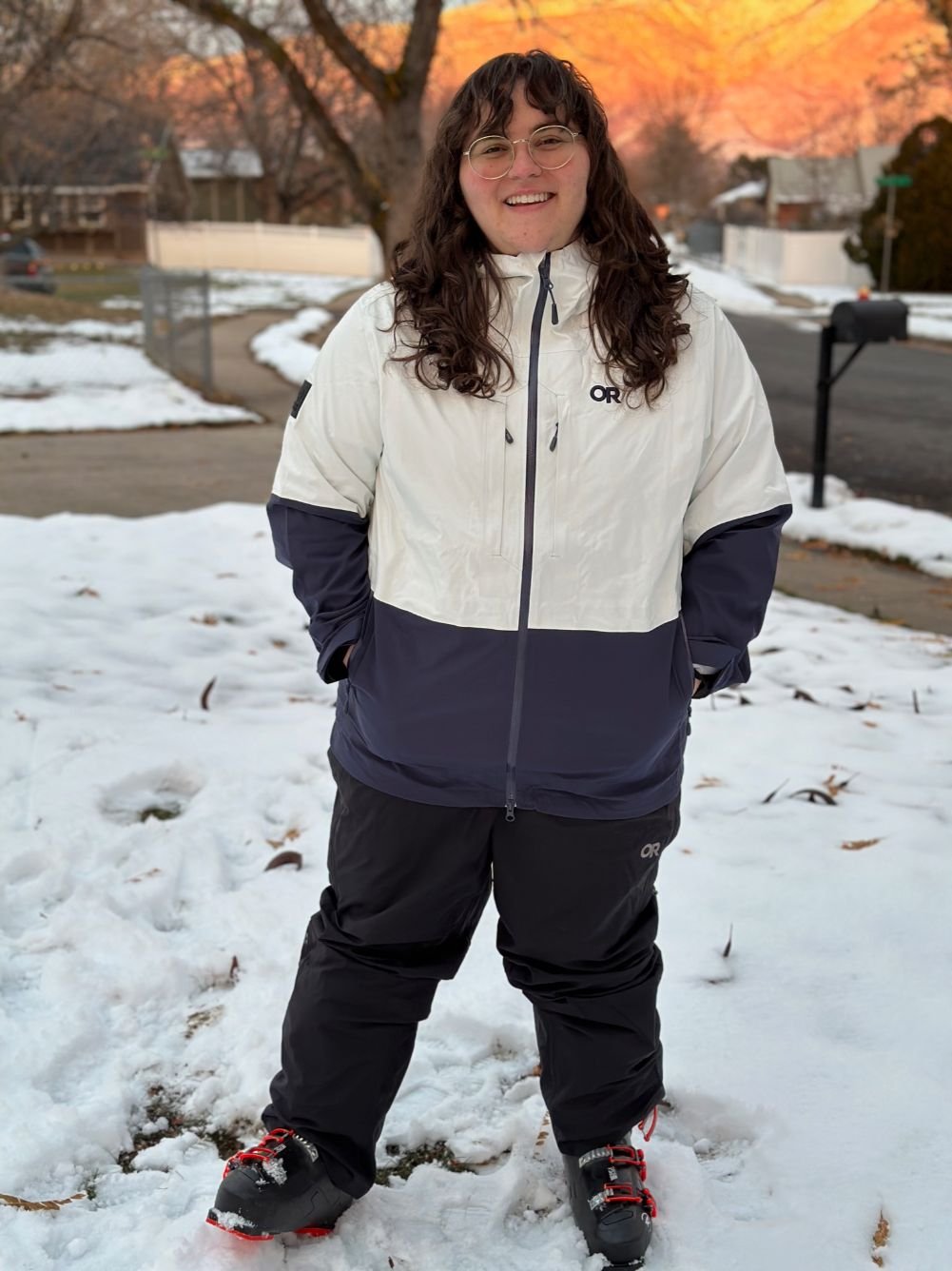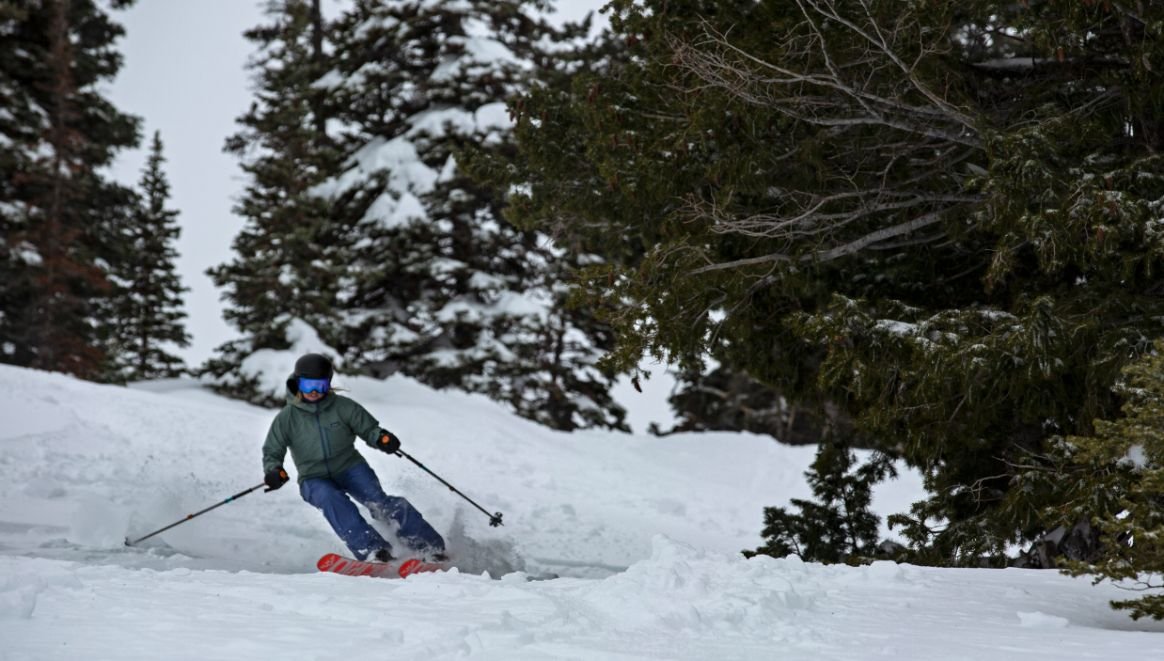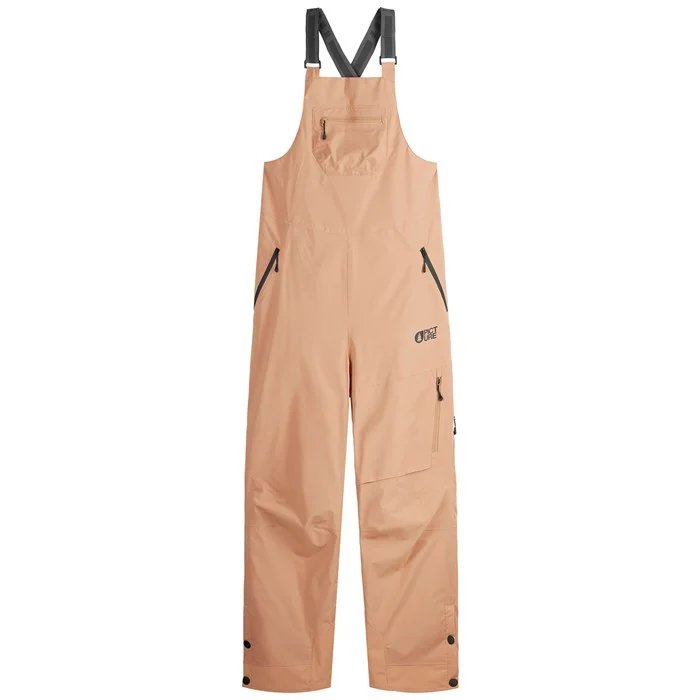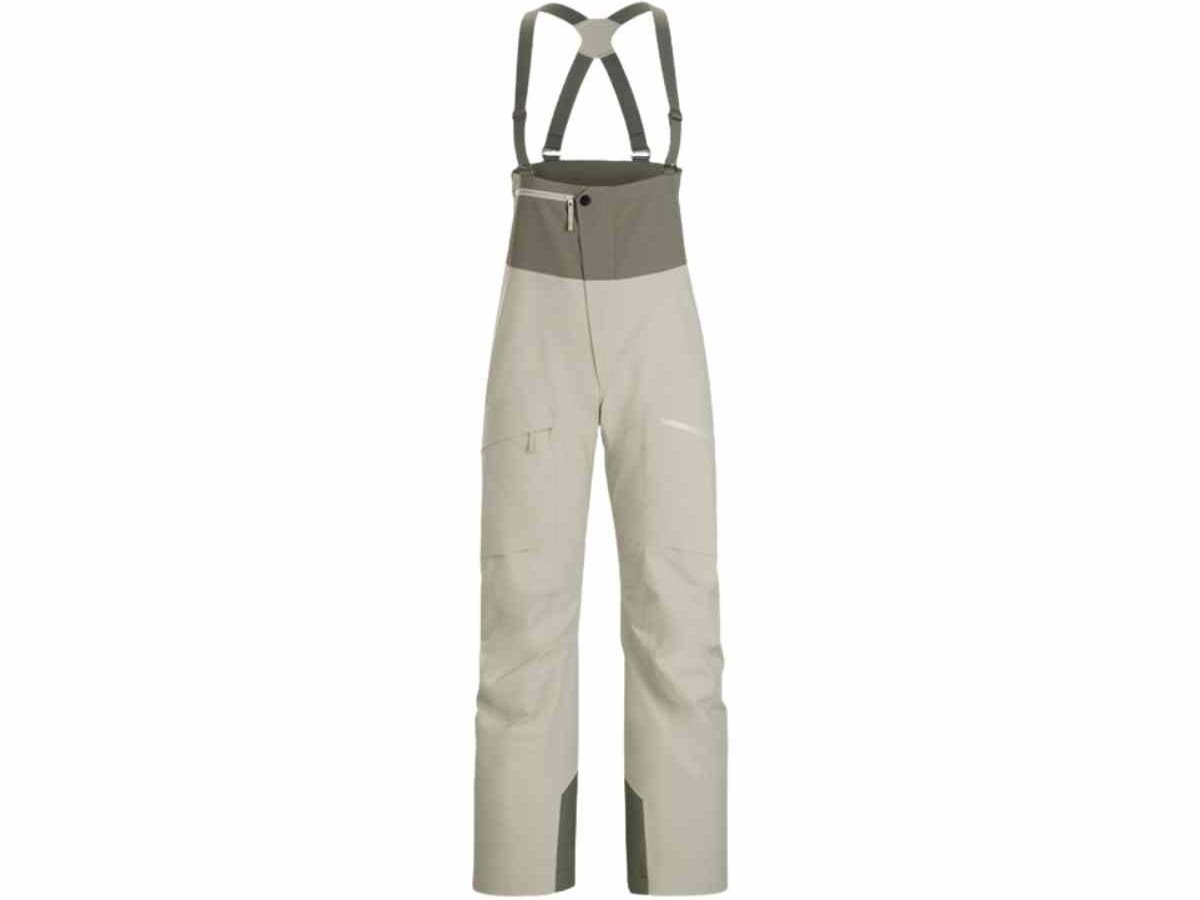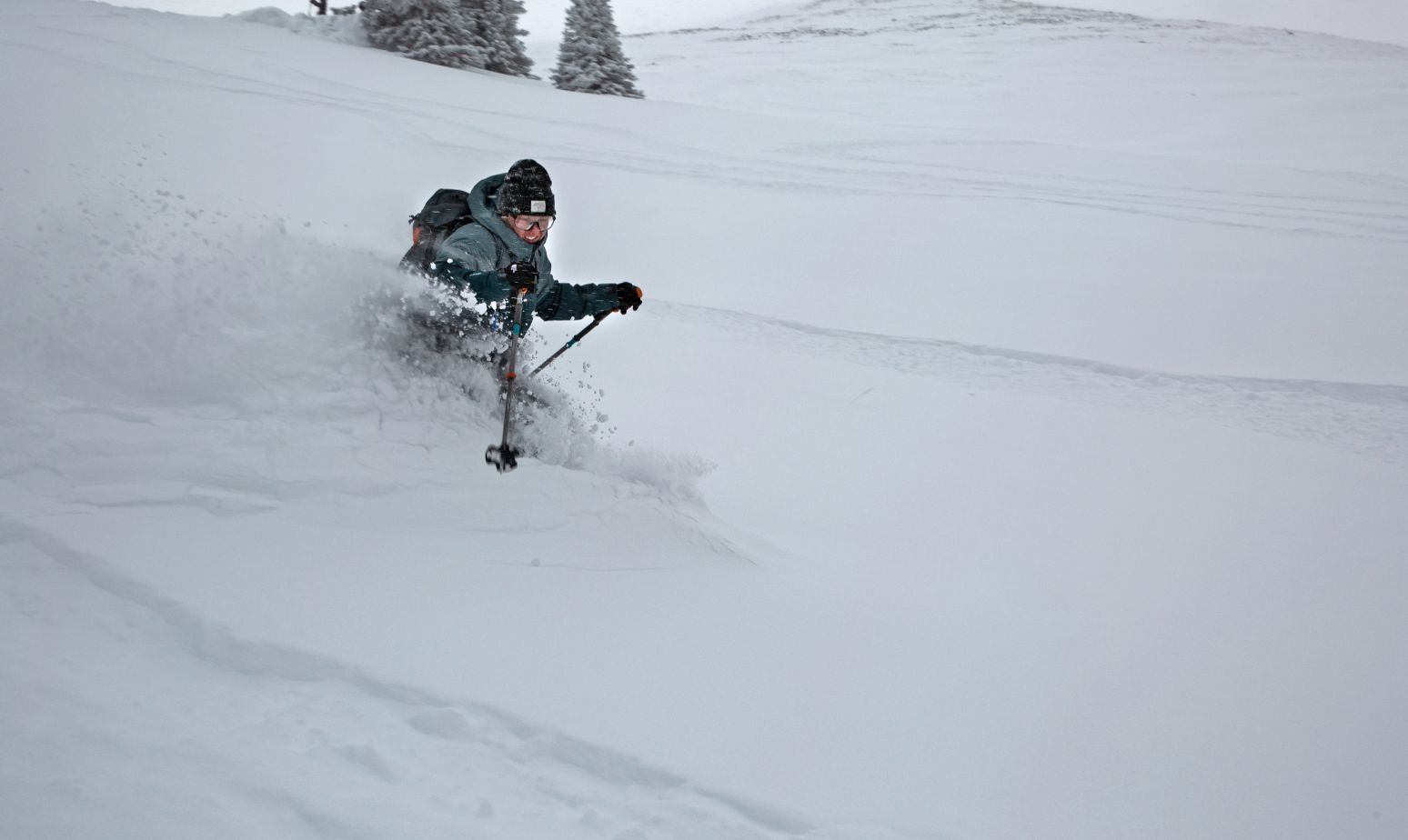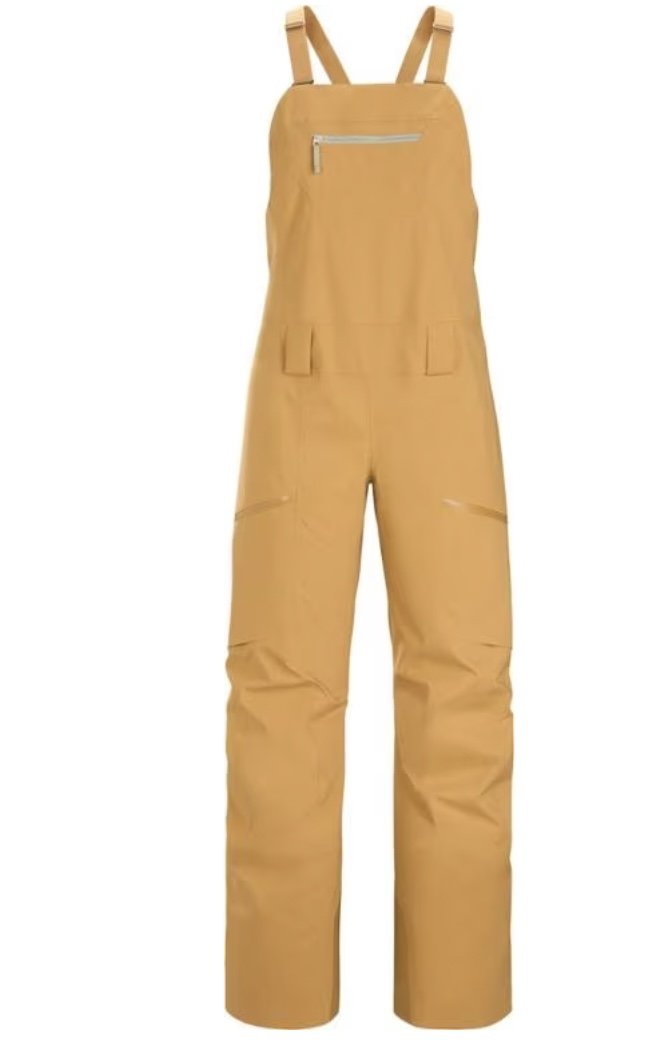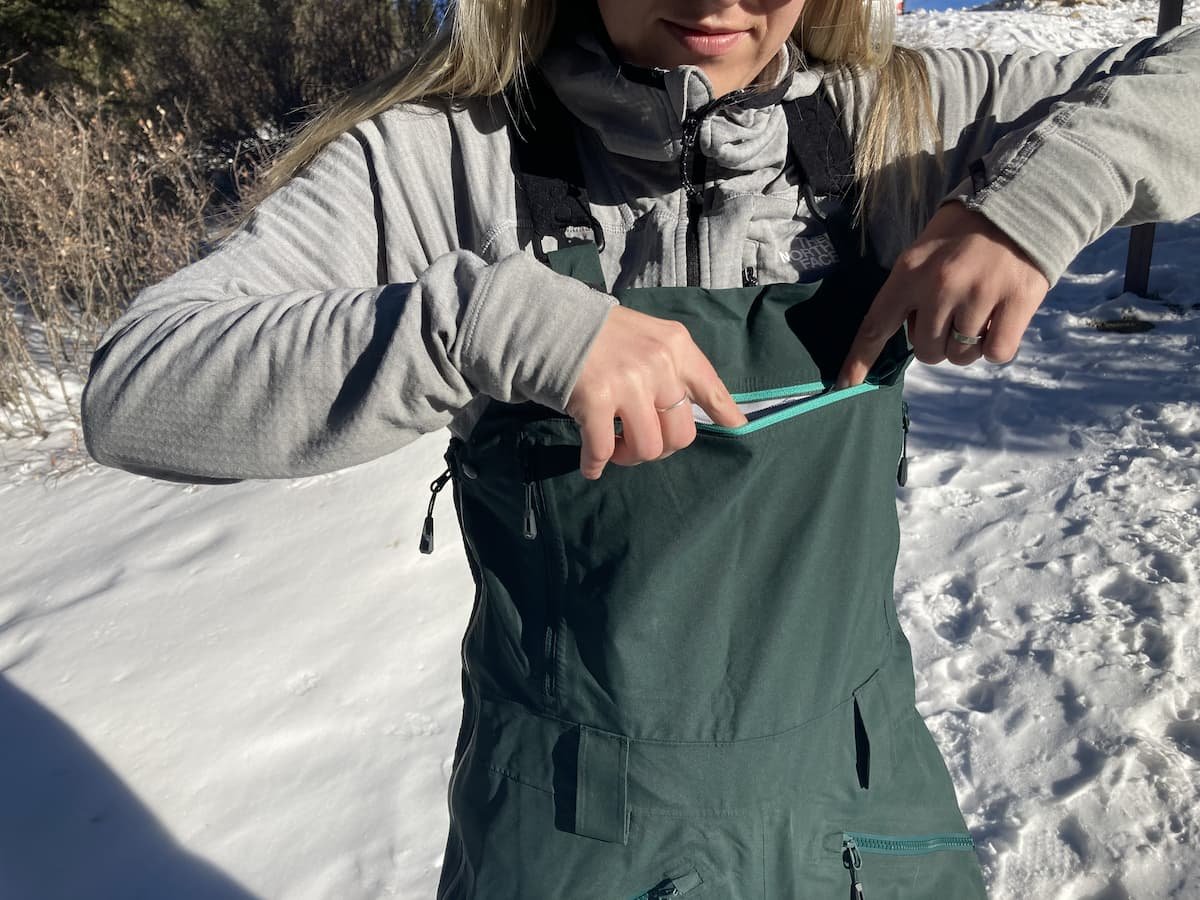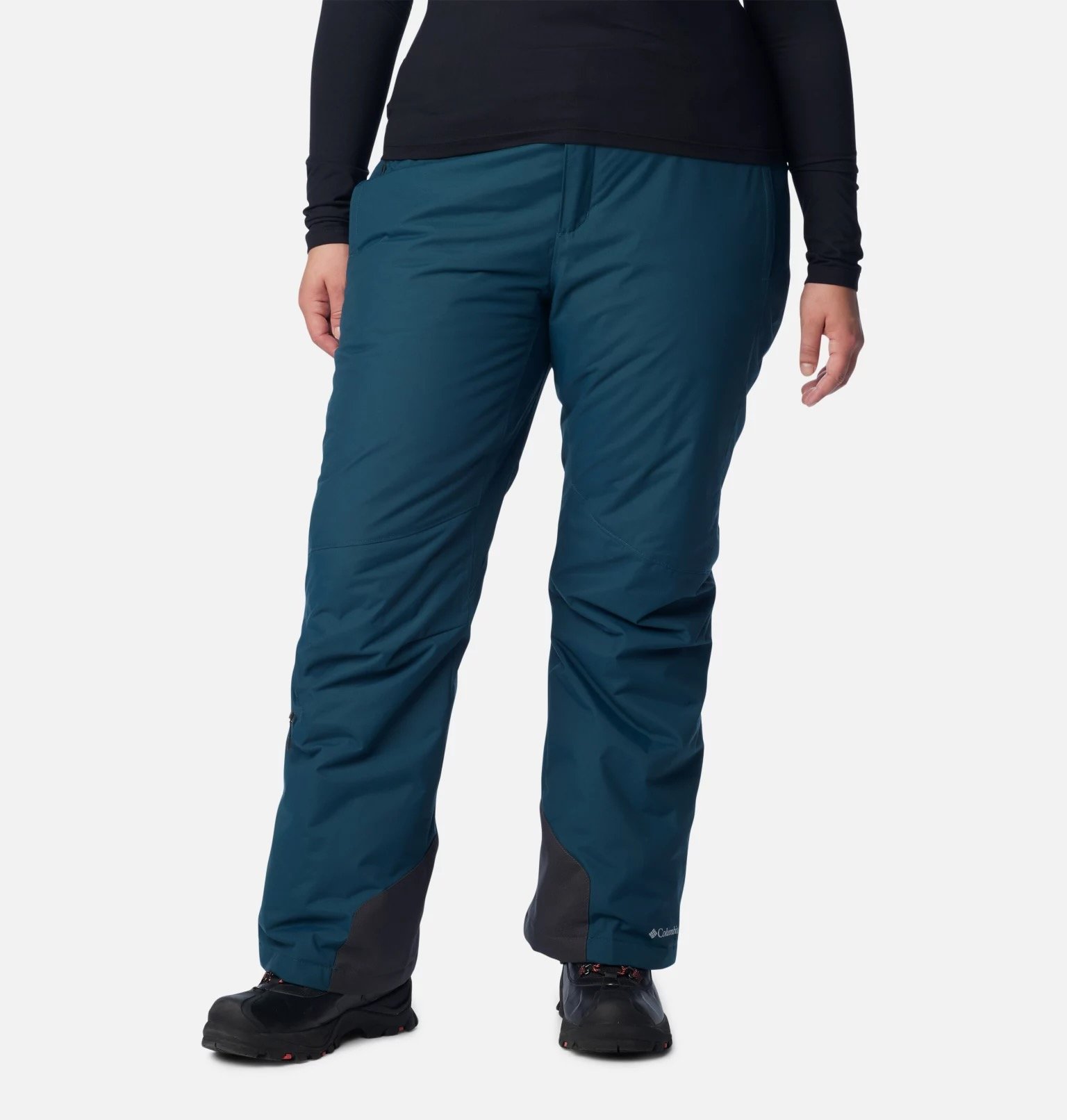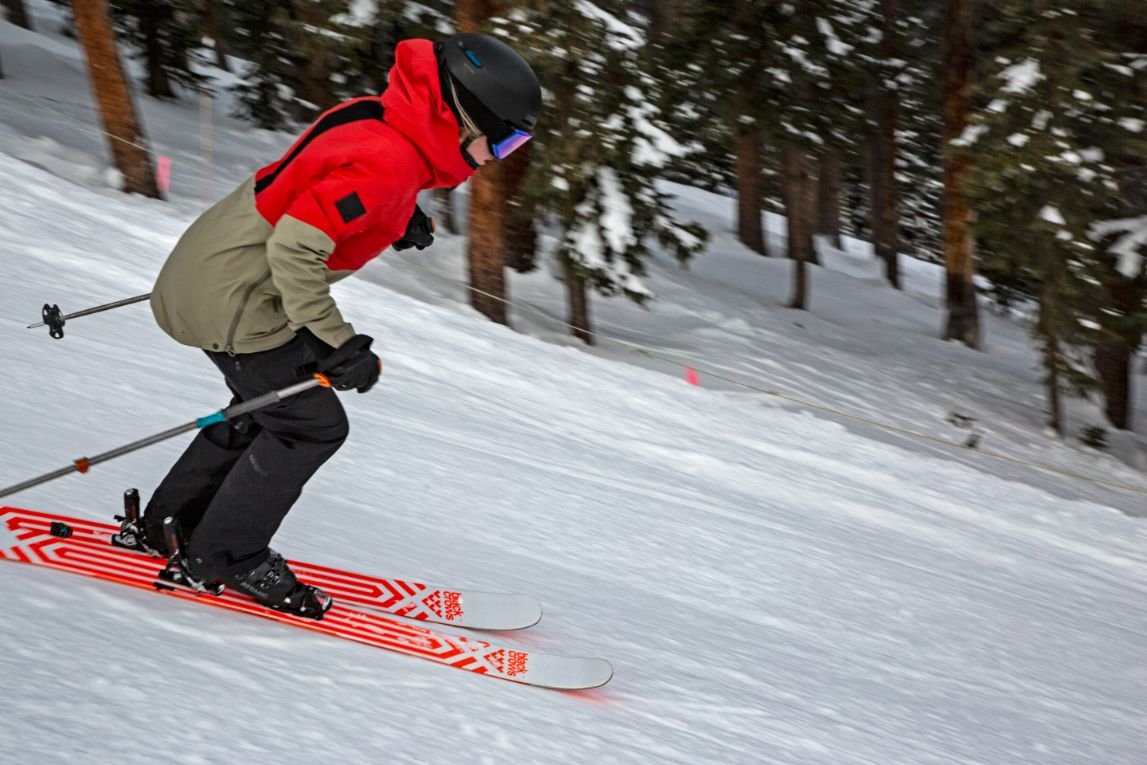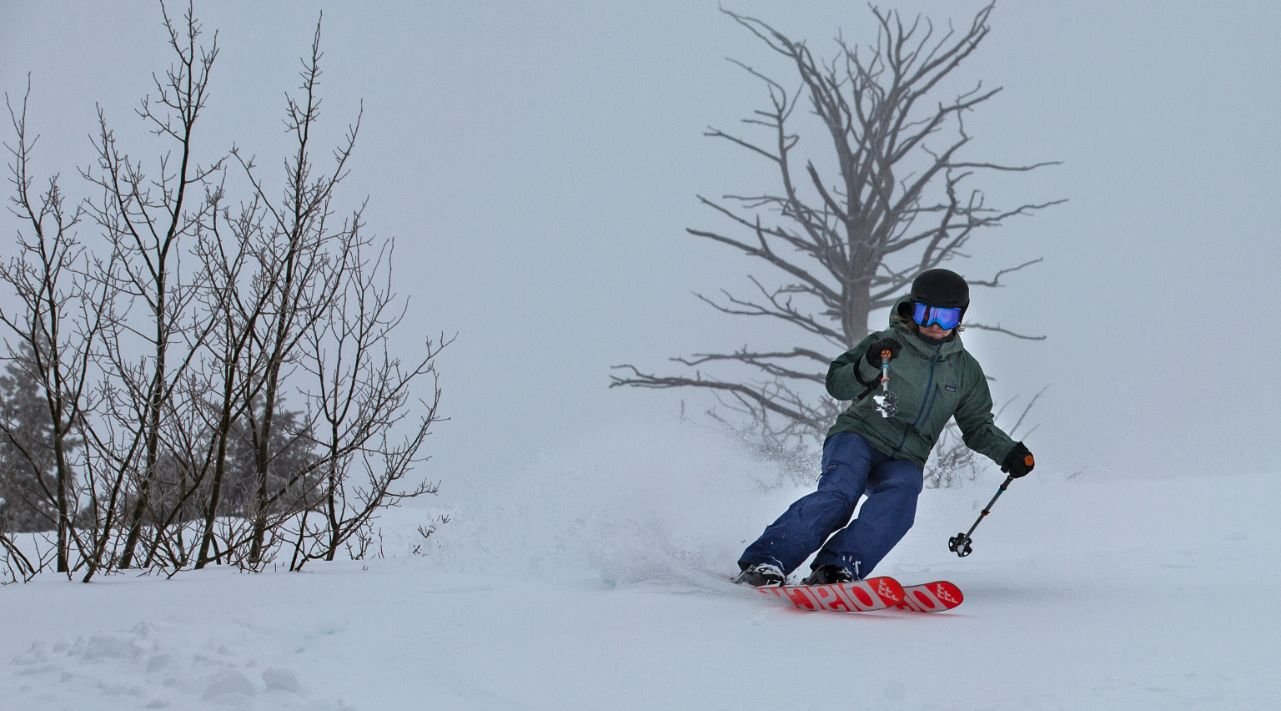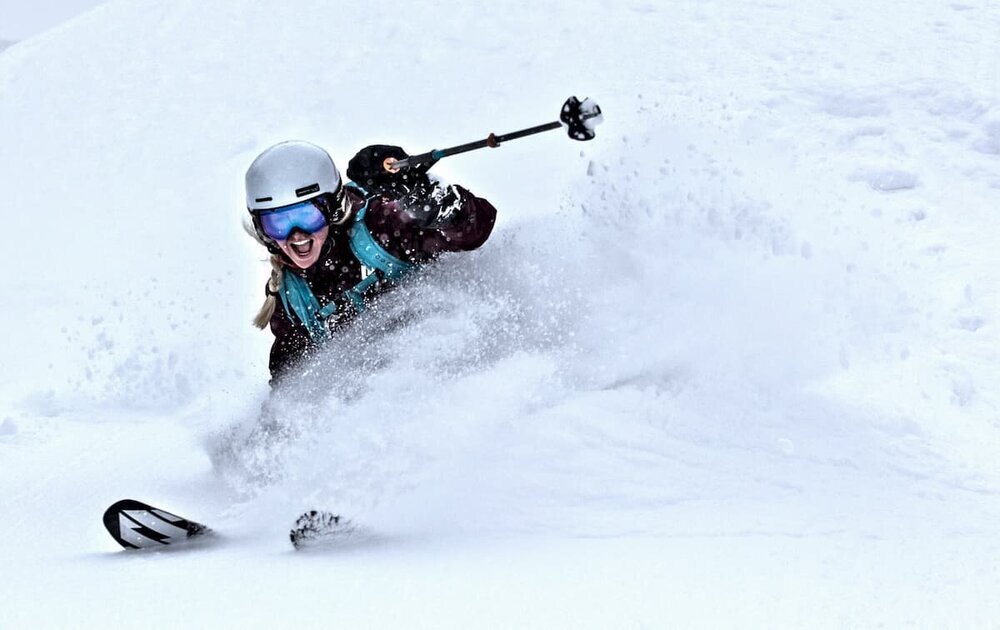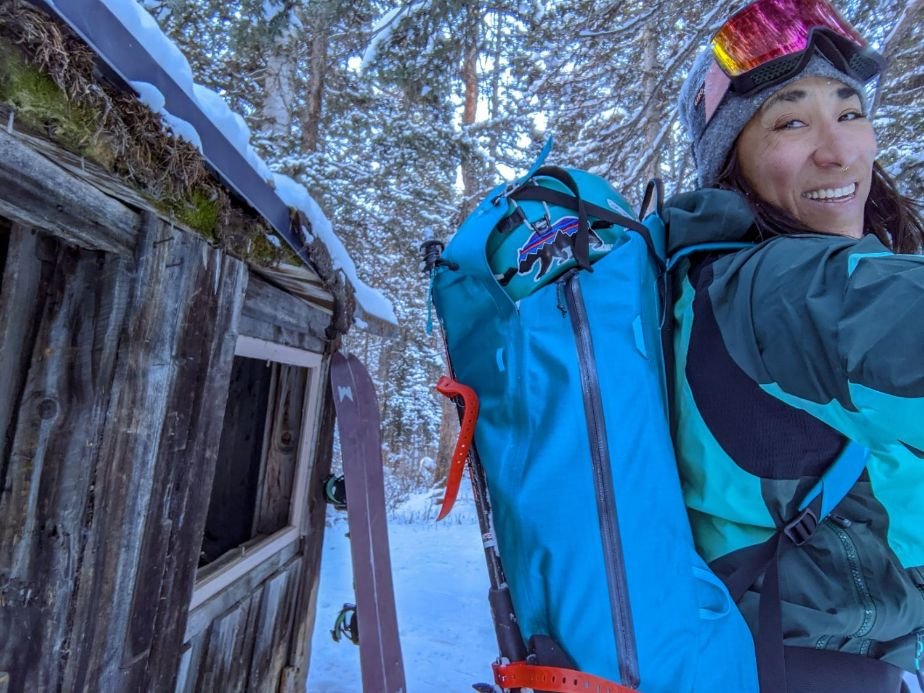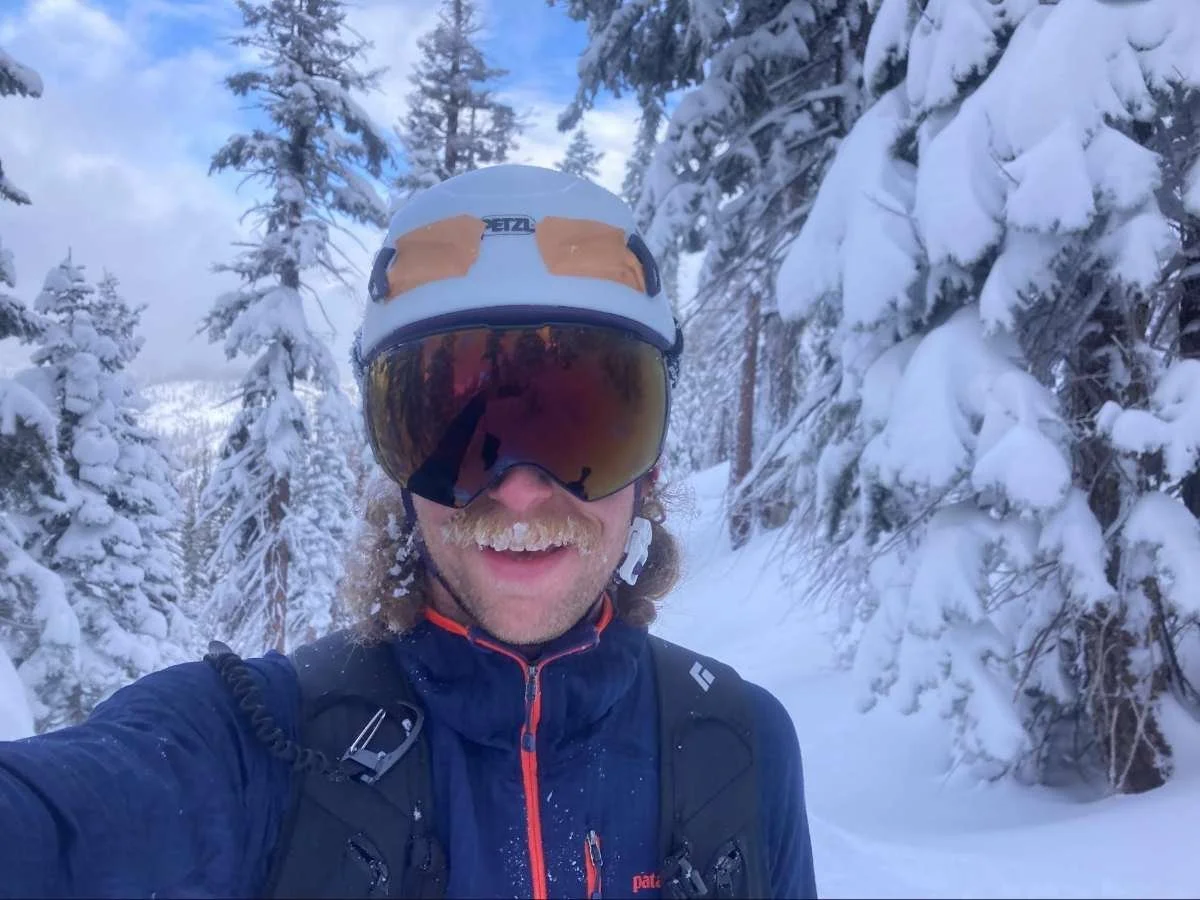Best Women's Ski Pants of 2024
THE TOP SNOW PANTS FOR the ski RESORT, BACKCOUNTRY SKIING, SKI TOURING, CROSS COUNTRY, and SNOWBOARDING
Updated May 1st, 2024
Whether you’re lapping downhill at the resort, exploring cross-country trails, touring deep into the backcountry, or snowboarding, having the best women's ski pants make the difference between feeling warm, dry, and comfortable and taking a beating from winter weather.
Our lifelong skier and ski shop employee in Colorado's high country tested snow pants for 3 seasons daily at the local resort and backcountry ski touring and on hut trips. We even tested them during an AIARE Avalanche Rescue course. We tested 15+ of models, comparing features, specs, and reviews to find the best women’s ski pants and bibs.
Related: Best Women’s Ski Jackets
Looking for men’s? See our Best Men’s Ski Pants guide
We create reader-supported, objective gear reviews independently selected by our editors. This story may contain affiliate links, which help fund our website. When you click on the links to purchase gear, we may get a commission — without costing you an extra cent. Thank you for supporting our work and mission of outdoor coverage for every body! Learn more.
women’s ski pants Comparison Table
| WOMEN'S SKI PANTS | TREELINE AWARD | MSRP | PANT STYLE | SIZES | MATERIAL | POCKETS |
|---|---|---|---|---|---|---|
| Arc'teryx Sentinel | Best Overall Read why |
$550 | Bib or pant (shell) | 0-16 (short, regular, tall) | 3L GORE-TEX with flannel backer | 2 thigh, 1 stash |
| Flylow Foxy Bib | Best Full Bibs Read why |
$430 | Bib (shell) | XS-XL (short, regular, tall) | Tactic 3L + DWR | 2 chest, 1 kangaroo, 3 thigh |
| Outdoor Research Skytour AscentShell | Best Ski Touring Bibs Read why |
$399 | Bib (shell) | XS-XL (short, regular) | AscentShell 3L electrospun | 2 zippered thigh, chest with beacon attachment |
| The North Face Freedom Insulated Pants | Best Budget Read why |
$220 | Pant or bib | XS-3X (short, reg, long inseam) | 2L DryVent waterproof shell | 2 hand; 1 cargo |
| Outdoor Research Hemispheres II Bibs | Best Backcountry Gore-Tex Read why |
$649 | Bib (shell) | XS-XL | GORE-TEX 3L C-Knit | 2 thigh,1 chest,1 kangaroo |
The Best Women’s Ski Pants
Best Women’s Ski Pants: Arc’teryx Sentinel
Insulated or Shell? Shell
Sizes: 0-16 (short, regular, tall)
Material: 3 L GORE-TEX with flannel backer
Pockets: 2 zippered thigh pockets, 1 zippered stash pocket
Vents: Thigh zips
Removable waist belt: Yes
Reinforced cuffs: Yes (PowderCuffs)
Waterproof Rating (mm): 28,000
Breathability (g): 20,000
What we liked: durability, waterproofing, breathability, comfortable fabric, ventilation, technical features
What we didn't like: price
Our longtime winner for the best hardshell ski pants got an update this year, and it remains our top choice. Arc’teryx has shed the “AR” (all around) and “LT” (lightweight) labels that accompanied models from their ski line in previous seasons, so these pants are now simply the Sentinel (and what would have previously been the Sentinel AR pant). Though the Sentinel pants are some of the most expensive, they’re also the toughest pair of hardshell snow pants in our test. If you’re looking for a top-of-the-line pair of ski pants to wear wherever you like to ski, the Sentinel should be at the top of your list.
These hardshell pants are made with a three-layer GORE-TEX shell fabric that’s full wind and waterproof. They have a very lightweight flannel backer fabric on the inside that adds just a touch of warmth without sacrificing too much breathability. For this reason, the Sentinel is slightly more resort-oriented than the backcountry, but these pants are versatile enough for both.
ARC’TERYX SENTINEL SKI PANTS
The author skiing at Snowbasin, Utah wearing the Arc’teryx Sentinel (bib version). Photo by Tom Callaghan.
The author wearing the Arc’teryx Sentinel pants while backcountry skiing. The Sentinel pants excel in both the front country and backcountry making them a versatile choice.
The Sentinel is still a shell, though—there is no real insulation in these pants, so they're best for folks who like to layer. (If you want Arc’teryx’s lighter version designed specifically for backcountry touring, consider the Arc’teryx Rush bib.)
The pants have two spacious thigh pockets with watertight zippers. They include a built-in belt, and belt loops if you prefer to wear your own belt. Integrated internal gaiters fit over ski boots to keep snow out, and on the instep, they sport an extra burly 100-denier (read: super thick and tough) cuff, which is by far the most durable of any pants in our test. These pants have outer thigh zips on each side that dump heat well for ventilation.
Arc’teryx has changed up the sizing for pants and bibs this season, opting for numerical sizing rather than the S/M/L of the old Sentinel AR. The new numbered sizing allows for a more nuanced fit, which we appreciate.We’ve found the new sizing to run slightly small. We’d recommend sizing up if you’re on the fence or prefer a roomier fit.
The style of the Sentinel has not changed much, and the pants have a good overall style. They offer a sleek and technical look with a freeride fit. (This generally means that the fit is on the looser side without being too baggy.)
The author skiing at Snowbasin in Utah in the Arc’teryx Sentinel ski pants. Photo by Tom Callaghan.
We tested the updated Sentinel over dozens of days of use at the resort—on beautiful bluebird days, in snow that was so wet and heavy that it was almost rain, and in the alpine with gusts of wind that nearly knocked us over. We also tested the older model over 20-plus days of resort and backcountry skiing and never encountered a single durability concern. The Sentinel stood up to it all. These are the most weatherproof and durable pants in our test.
Other than the sizing, the only negative thing we’ve found with these pants is the price. These are definitely a splurge, but a worthy one, especially for skiers who put their gear through the wringer.
The author skiing at Copper Mountain, Colorado in the Arc’teryx Sentinel ski pants. Photo by Tom Callaghan.
If you’re a skier who only gets out a couple times each season, then it really isn’t necessary to spend this money; there are plenty of other options out there at a more affordable price that still perform very well.
However, if you get out as much as possible each season no matter the conditions, these pants are worth the extra cash. For one, the superior durability means that you will get more seasons and days of use out of these than you would others, which ultimately saves you money and keeps stuff out of the landfill and in rotation.
The Arc’teryx Sentinel ski pants have a durable cuff that is reinforced.
Second, the weatherproofing in these pants is ready for just about anything. If the wind is howling or wet snow is dumping but you don’t want to go in the lodge, these pants will keep you out there all day long and you’ll stay warm and dry.
The Sentinel pants are produced in a Fair Trade Certified facility that promotes the well-being of the people who make them.
We think these pants are some of the most durable ski pants you’ll find anywhere, so they’re likely to last several seasons of hard use.
Additionally, Arc’teryx offers a good warranty and repair program to keep your gear in rotation and out of the landfill.
Arc’teryx also has a bib version of the Sentinel, which we tested this season. You can read more about it below. Ultimately, due to the price and some sizing issues, we think the Flylow Bibs are a better option for most skiers. However, the Sentinel Bib offer RECCO, which is one thing we wish the ski pants version also had.
In addition to holding our best overall award for several seasons, the Sentinel pants have acquired many 5-star customer reviews and held Outdoor Gear Lab’s editor’s choice award for several years, including this minor update to the pants. Other outdoor media outlets, including Powder, Gear Junkie, and Switchback Travel have also recommended the Sentinel pants.
If you’re looking for a pair of snow pants that can stand up to just about whatever you or the weather throw their way, the Sentinel should be at the top of your list. These pants take the cake for weatherproofing and durability and don’t slack on comfort or style, either. If a top-of-the-line pair of shell ski pants is what you’re after, look no further.
Best WOMEN’s Full Ski Bibs: Flylow Foxy
Insulated or Shell? Shell
Sizes: XS to XXL (short, regular, long inseams available)
Material: Tactic 3L + DWR
Pockets: 1 kangaroo chest pouch, 2 chest pockets, 2 mid-thigh pockets, 1 pleated thigh pocket
Vents: Inner thigh vents
Reinforced cuffs: Yes
Waterproof Rating (mm): 20,000
Breathability (g): 20,000
What we liked: fit, durability, weather protection, comfort, style, stretch, and mobility
What we didn't like: not quite as waterproof or breathable, getting sizing right can be tricky
For durability, weather protection, and comfort in a stylish package, it's hard to beat the overall quality of the women’s Flylow Foxy bib. Skiers looking for full protection on powder days in a bib-style pant will want to consider this waterproof, breathable shell bib. Our testers have loved the fit of the Foxy. It offers enough leg room for skier quads while still maintaining a great and flattering style. We tested the Foxy in various conditions across Colorado's high country and found them weatherproof, durable, feature-packed, and good-looking—all at a reasonable price.
FLYLOW FOXY BIBS
Our testers loved the fit of the Flylow Foxy with just enough room in the legs for skier quads, while still being stylish.
The Foxy is made with a 3-layer Stormshell Intuitive shell fabric that offers weather protection with a touch of stretch for comfort and mobility. A DWR (Durable Water Repellent) coating adds moisture-shedding properties to the pants, while waterproof zippers keep what’s in your pockets dry. The Foxy has two zippered thigh pockets, a zippered chest pocket, and a kangaroo pouch in the bib.
Other bonuses in the Foxy include a side zipper that allows for drop-seat capabilities, meaning you don’t have to fully strip down when nature calls in the backcountry (we consider that essential in a good women's bib). This bib has outer and inner thigh vents for maximum airflow on warm resort days and toasty ski tours.
Most customer reviews mention that the fit of the Foxy is very flattering. Some skiers say it can be tricky to find just the right size. In that case, we recommend carefully looking at Flylow’s size chart before you buy and consider purchasing from a vendor with an easy exchange policy that reimburses shipping costs like REI. In our testing experience, the top of the bib can fit snugly on ladies with larger chests. If that’s you, consider sizing up or trying them on first.
The author skiing in the Flylow Foxy Bibs in the high country of Colorado.
Several outdoor media reviews recommend the Foxy bib, including Powder, Outdoor Gear Lab, Gear Junkie, and The Adventure Junkies. Most customer reviews (including at Evo, Backcountry, and REI) award the Foxy 5 stars for the bibs' flattering fit and technical features.
We tested the Foxy in various conditions across Colorado's high country and found them weatherproof, durable, feature-packed.
They fall on the less expensive side compared to other waterproof hardshell bibs, so feel a little less waterproof and a little less ventilated than what the Arc'teryx Sentinel's fabric can offer. We have worn them for an entire season in a variety of conditions. The Flylow Foxy is our top choice for an all-around weatherproof resort bib.
Related: Best Women’s Winter Boots & Best Men’s Winter Boots
BEST Women’s SKI TOURING BIBS: OUTDOOR RESEARCH SKYTOUR ASCENTSHELL
Insulated or Shell? Hardshell
Sizes: XS to XL
Material: AscentShell 3L electrospun waterproof-breathable hardshell
Pockets: Zip secure pocket on bib with beacon clip, 2 large cargo pockets
Vents: zippered outer thigh vent
Reinforced cuffs: Yes
What we liked: comfort and breathability during exertion, pockets, value
What we didn't like: not quite as waterproof as other bibs
When it comes to finding a pair of ski pants that offer exceptional comfort and breathability for the uphill without sacrificing weatherproofing, we’ve found a winner with the Skytour AscentShell Bibs. These ultra-comfortable bibs are the perfect companion for all-around backcountry skiing, and they stand up to resort use as well.
Weatherproofing in these bibs also impressed us with how light, soft, stretchy, and comfortable they are. Even when riding chairlifts mid-snowstorm, the Skytour remained both water and windproof. The Skytour has generous outer thigh vents to dump heat for venting. Even on warm, sunny spring tours, our testers didn’t need ventilation as the shell fabric offers good breathability.
If you’re a backcountry skier looking for a comfortable, hardshell bib that tours well and stands up to resort use, the Skytour is our top winner. While other bibs might offer slightly more protection in exceptionally wet weather, we think this bib pant is the ideal combination of protection, comfort, performance, and price. We heartily recommend the Skytour AscentShell Bibs.
OUTDOOR RESEARCH SKYTOUR ASCENTSHELL BIBS
The author skiing in the Outdoor Research SkyTour bibs.
The Skytour bib is made with Outdoor Research’s AscentShell material, a waterproof-breathable shell fabric that offers more stretch and breathability than traditional GORE-TEX shells. This material is the primary reason we love the Skytour so much for backcountry skiing. It has the stretchy, comfortable, and never-crinkly feel of a softshell with the performance of a hardshell.
This fabric is an update of the lauded Outdoor Research Skyward II fabric that we liked in previous iterations of this guide. The Skyward II won multiple awards in our women's and men's ski jackets guides—and we found the updated SkyTour fabric even better. The main difference between Outdoor Research AscentShell fabric and Outdoor Research Skyward II is more breathability and stretchiness.
The pockets on the Skytour bibs are just what we need and nothing we don’t. Two thigh pockets offer ample storage, while a chest pocket has a dedicated clip for safely storing a beacon. We particularly like this location for a beacon pocket as it provides easy access and doesn’t weigh down the pants in a thigh pocket.
We tested these pants during an AIARE Avalanche Rescue course where our tester had to access her beacon constantly, and we found this to be the ideal location for a beacon pocket. (Note: If you store your beacon in a pocket instead of a harness, ensure it has the necessary attachment. Not just any pocket will work. It must have a strap or clip stitched on the inner pocket so that your beacon is secure.)
The author ski touring in the Skytour Bib at sunrise in the Colorado high country.
After an entire season of use, the Skytour bib has proven durable. The zippers are tough, the fabric holds up, and the reinforced cuffs keep the bottoms intact and safe from ski edges or crampon spikes.
The Skytour is, hands down, the most comfortable of all the bibs we tested. They offered more than enough freedom of movement for long days on the skin track and never constricted our testers while skiing. The one area the Skytour could improve is style. These bibs fit a bit baggy on the backside and in the legs. However, this bagginess is a minor factor and hasn’t stopped our testers from loving this ski bib.
OUTDOOR RESEARCH SKYTOUR VS. FLYLOW FOXY
Consider your primary use if you’re in a toss-up between the Flylow Foxy and the Outdoor Research Skytour. If you spend most of your time in the resort, the Foxy offers excellent weatherproofing, durability, and style. If you earn your turns and spend a great deal of time heading uphill on the skin track, the Skytour will give you freedom of movement and breathability (priorities in the backcountry when you’re wearing a ski backpack).
Related: Best 4 Season Tents
BEST BUDGET WOMEN’S SKI PANTS: THE NORTH FACE FREEDOM
Insulated or Shell? Insulated pants or bibs
Sizes: XS to 3X (available in short, regular, and long inseams)
Material: 2L DryVent waterproof shell, 60 g synthetic insulation
Pockets: Zippered hand pockets, 1 velcro thigh cargo pocket
Vents: Inner thigh vents
Adjustable waistband: Yes
Reinforced cuffs: Yes
What we liked: value for the price, wide availability of sizes, styles, and patterns, storage
What we didn't like: not as ventilated or waterproof
If you’re looking for a great pair of ski pants but don’t want to spend too much money, we think The North Face Freedom Insulated pants are the best ski pants for those on a budget. We also award the North Face Freedom pants the Best for Resort Skiing. These insulated ski pants have handy ski-specific features paired with adequate weatherproofing for days spent lapping the ski resort. They are also available in short, tall, and bibs. The Freedom pants are our recommended pick for folks who want resort-specific ski pants.
In fact, we like The North Face Freedom pants so much, we dedicated a whole article just to these incredible bang-for-the-buck ski pants.
THE NORTH FACE FREEDOM INSULATED SKI PANTS
The author skiing Arapahoe Basin in Colorado in the North Face Freedom Insulated Pants. Photo courtesy Stasia Stockwell.
The Freedom pants are fairly basic ski pants, pared down to only the essentials you need in a solid pair of weekend ski resort pants. With two zippered hand pockets and one Velcro pocket on the thigh, you’ll have ample storage for essentials on the slopes.
Zippered mesh thigh vents offer some airflow for warm days. However, the mesh doesn’t allow for quite as much ventilation as open zippers like those on our other winners, the Arc’teryx Sentinel, Flylow Foxy, or Outdoor Research Hemispheres.
The North Face Freedom Insulated pants are windproof and waterproof pants that are ideal for riding chairlifts because they offer warmth without bulk, but not so much that you’ll overheat when you start working hard. Photo courtesy Stasia Stockwell.
The DryVent shell fabric gives The North Face Freedom moderate weatherproofing with a bit of breathability that’s plenty for average resort days. Velcro waist adjustments help with fit, and reinforced cuffs add durability.
The Freedom has 60 grams of synthetic insulation for skiers who need the extra warmth. (The Freedom Insulated pant also comes in tons of great colors!)
Customer reviewers love the comfort of the Freedom pants, and most agree that the fit is great. Reviewers of the Freedom Insulated love the warmth. These pants are recommended by many media outlets, including Outdoor Gear Lab, Gear Junkie, and The Adventure Junkies (see sources).
Overall, if you’re looking for solid insulated snow pants for days at the resort, the Freedom pants are a great option. If you need more technical features or better weatherproofing, we recommend the Arc’teryx Sentinel (see our full review above), though it comes with a much higher price tag. Folks who plan to spend any significant amount of time in the backcountry would benefit from pants with better stretch and ventilation, like the Outdoor Research AscentShell bib (see our full review above).
But if you’re just looking for the basics, or you’re a beginner, there’s no need to spend the extra money. The Freedom pants offer plenty of function, style, and warmth (if you want it) at a great price.
THE NORTH FACE FREEDOM VS. COLUMBIA BUGABOO
The North Face Freedom and Columbia Bugaboo snow pants are somewhat similar in features but have some essential differences tailored to different skiers and budgets. Both the Freedom pants and the Bugaboo pants have insulation.
The Freedom pants have mesh inner thigh zips for venting, while the Bugaboo pants do not have any venting. The key difference for this review, and the primary reason we’ve included the Bugaboo, is because it comes in plus sizes, ranging from XS-3X.
For those needing a wider range of sizes, the Columbia Bugaboo is a good insulated resort pant at a great price. We'd recommend the Freedom pants if you’re looking for regular shell pants at a reasonable price or want leg zips for ventilating on insulated resort pants. Jump to our full review of the Bugaboo here.
THE NORTH FACE FREEDOM VS. ARC’TERYX SENTINEL
While the Freedom and Arc’teryx Sentinel pants are both ski pants, the fabric and technical features differ significantly (as well as the price tag). So what do you get if you spend extra on the Arc’teryx Sentinel? What do you miss out on if you go with the North Face Freedom instead?
If you do any ski touring, ski a couple of times a week, or need superior weatherproofing and durability for the conditions you plan to encounter, go with the Arc’teryx Sentinel pants. The Sentinel pants use a top-of-line breathable waterproof fabric that will keep you comfortable in harsh conditions. If you plan to ski tour at all, you’ll notice and appreciate the difference. It’s worth spending the extra money for increased breathability and waterproofing. See our full review above for why we think these are the best ski pants for most skiers.
But if you’re on a budget, the Freedom pants, with moderate weatherproofing and durability, make excellent pants for casual use at the ski resort. They also come with insulation if you need extra warmth. If you are light on ski gear, ski only at the resort, or only get out a handful of days each year, the Freedom pants are ideal, especially given the price.
Best Backcountry Gore-Tex Ski Bibs: Outdoor Research Hemispheres II Bibs
Insulated or Shell? Shell
Sizes: XS-XL
Material: GORE-TEX 3L C-Knit
Pockets: 2 thigh pockets, zippered chest pocket, zippered kangaroo pocket
Vents: outer thigh vents
Reinforced Cuffs: yes
What we liked: comfort, stretch, waterproofing, fit, lightweight, breathability, venting, gaiter design
What we didn't like: price
You can't beat the Outdoor Research Hemispheres II bib when it comes to finding a pair of ski pants that offer superior weather protection and ultimate comfort for long days in the backcountry. This bib has all the features you could ask for in an ideal backcountry ski touring pant, and even though it comes in at a high price point, we believe it’s worth it for the right skier.
The Hemispheres II is an updated version of the original Hemispheres (which are still available). They’re still made with the same GORE-TEX material, including the stretch panels. Outdoor Research improved the fit and added a few features for this refresh, and we love them even more than before. The Hemispheres II is our top choice if you’re looking for a fully weatherproof pair of bibs that are still light and breathable for the backcountry.
OUTDOOR RESEARCH HEMISPHERES II BIBS
The author skiing in the Outdoor Research Hemispheres II bibs.Photo courtesy Stasia Stockwell
The author backcountry skiing in the Outdoor Research Hemispheres II bib.
The Hemispheres is a waterproof and windproof full bib design, meaning it comes up to the chest in front and falls just below the shoulders in the rear. These bibs have pockets galore: a zippered chest pocket plus a kangaroo pocket on the bib and two zippered hand pockets on the thighs, where you can safely store an avalanche beacon for backcountry ski tours.
Both the main chest pocket and one thigh pocket have clips for a beacon, so now you have options on where to stash it. Large outer thigh zips vent heat and zip into a drop-seat for easy access to the backcountry bathroom. A unique feature of the Hemispheres is the gaiter design, which has slots that allow you to strap the power strap of your boot around the snow gaiters to prevent it from riding up or allowing any extra snow in on deep days.
The most appealing and innovative aspect of the Hemispheres II bib is the material: a combo of GORE-TEX C-Knit and GORE-TEX Fabric with Stretch Technology. The pants are fully windproof, waterproof, and breathable while being the stretchiest and most comfortable for ski touring. GORE-TEX with C-knit is a waterproof fabric with a soft knit backer that adds comfort to the pants. The Stretch Technology is a waterproof fabric with exceptional stretch and is placed strategically on the back of the bib near the hips and back of the bib to allow for maximum freedom of movement on the skin track.
The Outdoor Research Hemispheres II bib are lightweight excel in wet conditions . Photo by Tom Callaghan.
One thing to note is that these bibs are a very lightweight shell, making them great for the backcountry but less ideal for cold resort days.
If you plan to ski primarily in the backcountry, these bibs are top-notch; however, if you mostly stick to the resort, we’d steer you towards the Flylow Foxy or Arc’teryx Sentinel bib for another bib option.
The Hemispheres II bibs fit true to size. Outdoor Research improved the fit with the update. The bibs are less boxy and have a more tailored fit while maintaining excellent freedom of movement. We appreciate the updates to the overall style and colorways for the Hemispheres collection.
The Outdoor Research Hemispheres II bibs has a reinforced cuff that adds durability.
We tested these bibs over days of skiing in the backcountry and at the resort, including two backcountry hut trips in Colorado. Just like the original Hemispheres, they offer excellent performance for backcountry touring and hold up reasonably well to resort laps, too. However, they are intentionally made with thinner fabric to keep them light for the backcountry, making them more prone to wear in the resort.
Nevertheless, these bibs were a workhorse for us during hours of touring in wind and blowing snow in single-digit temperatures. They worked just as well when the sun came out.
It’s worth pointing out that the Skytour bibs, our winner for Best Ski Touring bibs, are slightly more breathable than the Hemispheres, though they are less weatherproof (and also much less expensive). If you want more breathability or want to save some cash and don’t mind sacrificing a bit of weatherproofing, consider the Skytour. But, if you want a top-notch, fully wind and waterproof bib designed for the backcountry, the Hemispheres II is calling your name.
The original Hemispheres won Powder Magazine’s first-ever Apparel of the Year award and has racked up plenty of good customer reviews to boot. We’re not alone in recommending these bibs. The Hemispheres II are it for skiers who spend most of their time in the backcountry and want comfortable, feature-packed, weatherproof bibs.
Best Insulated Resort Ski Pants: Outdoor Research Snowcrew
Insulated or Shell? Shell
Sizes: XS-4X (short, regular, tall)
Material: 2-layer Ventia, VerticalX Eco polyester insulation (85% recycled)
Pockets: 2 zippered hand pockets, avalanche beacon pocket with clip in right hand pocket
Vents: inner thigh vent
Reinforced Cuffs: yes, scuff guard
What we liked: insulation, waterproofing, warmth, comfort, size availability, technical features, durability for price
What we didn't like: not quite as waterproof as more expensive pants
If you’re looking for a pair of pants to keep you toasty and dry while riding the chairlift all day long, the Snowcrew pants will have you covered. These insulated, waterproof ski pants will keep you out on the slopes longer, thanks to their warmth and comfort. Plus, we love that the Snowcrew is both affordable and available in a wide range of sizes, from XS up to 4X.
The Snowcrew pants are made with a two-layer weatherproof taped seams on Ventia shell material. The shell material has some stretch for added freedom of movement. The result of all this is a pair of ski pants that are comfortable and warm without being overly heavy or bulky.
They’re insulated with 45 grams of VerticalX ECO synthetic insulation (which is made with 85 percent recycled polyester) and designed to be loftier than most other synthetic insulation materials. We think these pants hit the sweet spot when it comes to insulation and warmth. They kept us warm, even when the temps lingered in single digits, without causing us to overheat or feel weighed down. When the wind picked up, these toasty pants weren't phased.
OUTDOOR RESEARCH SNOWCREW SKI PANTS
A Treeline Review tester in the Outdoor Research Snowcrew ski pants, our winner for best insulated ski resort pants.
Regarding ski-specific features, the Snowcrew pants have two upper thigh pockets.. There are inner-thigh zips for venting that work decently well but don’t vent or breathe as much as others in our test (as expected with insulated pants). An internal boot gaiter help keep snow out of your boots, and reinforced cuffs add durability. For more information, see our guide on How to Fit a Ski Boot.
The pants also have belt loops and Velcro adjustments to help dial in fit in the waist. We found the Snowcrew pants to fit slightly on the large side; if you’re in between sizes or prefer a more trim fit, we recommend sizing down. The pants are slightly baggy but have fairly good style overall.
We tested the Snowcrew pants at the ski resort in Utah and another Treeline Review tested them in California. We appreciated their warmth and freedom of movement. While they’re not entirely as weatherproof or breathable as high-end GORE-TEX shells (like the Arc’teryx Sentinel), they performed well in all but the nastiest conditions and kept us warm and dry.
The shell material on the Snowcrew pants is made with Bluesign-approved fabric, while the insulation contains 85 percent recycled materials. Outdoor Research also backs its gear with a good warranty. The overall durability of these pants is good, especially for the price. If you’re not too hard on your gear, these should last several seasons of use.
Skiers needing a comfortable pair of ski pants to keep warm and dry on the slopes should put the Snowcrew at the top of their list. You’ll find good quality, nice ski-specific features, and a wide range of sizes at a very reasonable price.
Best Plus Size Ski Bibs: Outdoor Research Carbide Bibs
Insulated or Shell? Shell
Sizes: XS-4X
Material: Pertex Shield shell
Pockets: zippered bib pocket, beacon pocket
Vents: drop seat, outer side vent zips
Adjustable waistband: built-in Arcade stretch webbing and suspenders
Reinforced cuffs: Yes
What we liked: high quality materials, construction, technical features for a great price, sizes available, mobility and stretch, venting, sustainability
What we didn't like: inseam is long
Plus-size ladies needing a technical hardshell for skiing, whether in the front country or backcountry, will find what they’re looking for in the Outdoor Research Carbide bibs.
We also think that these pants are great for skiers of any size who are looking for quality hardshell pants at an affordable price. Outdoor Research has been making efforts in the past couple of seasons to expand their plus-size offerings, and we’re impressed.
While we still wish there were more options with extended sizing (not just from OR but from everyone in the industry), we think the Carbide is a quality, versatile shell jacket for all skiers–and we're thrilled that this level of quality is available in plus sizes. Both our budget winner, The North Face Freedom, and our insulated resort winner, the Outdoor Research Snowcrew, are offered in plus sizes. If you’re looking for a more affordable or insulated option, those are both great.
However, we chose the Carbide as our top pick for this award because the Carbide has the most technical materials and features available for plus-size skiers—all at a price that is a value for the level of quality and materials you get.
OUTDOOR RESEARCH CARBIDE BIBS
The Outdoor Research Carbide bibs offer the best technical features, waterproof breathable material, and fit and comfort of any ski pants available in plus sizing. Although they aren’t quite a budget winner, they offer a lot of value as well.
The Carbide is a non-insulated shell jacket made with a three-layer Pertex Shield shell that’s wind and waterproof while remaining reasonably breathable. The shell material does have a touch of stretch that allows for good freedom of movement both at the resort and in the backcountry.
The Carbide bibs have one small zippered chest pocket and two zippered hand pockets on the thighs, one of which has a clip for a beacon. There's an internal boot gaiter to help keep snow from creeping in, and the cuffs have reinforced material on the instep for added durability. We found the bibs to fit fairly true to size, with the overall style and fit leaning on the roomy and baggy side (our tester tried the plus size version of these in a 2X). The inseam is a bit on the long side.
A Treeline Review tester in the Outdoor Research Carbide bibs, our winner for best plus size ski pants—and a great pair of pants for skiers of all sizes.
Order your usual size if you like plenty of room for layering underneath your bibs. If you prefer a more snug fit, consider sizing down. (Our opinion: It’s always nice to have extra layering room). The straps on these bibs are comfortable and easy to adjust, and a drop-seat zipper makes using the restroom easy. The bibs also have generous outer thigh zips for venting. Additionally, the Carbide is made with a Bluesign-approved shell fabric, which adds to the sustainability of the production.
We tested the Carbide bibs at the resort, and though we have not yet had the chance to ski tour in them, they seem like they will perform well both inbounds and in the backcountry. The shell fabric did well to fend off snow and wind, though they are not entirely as windproof or warm as other shells, like the Arc’teryx Sentinel (which admittedly, has a little added warmth from the flannel backer). The Carbide, however, also offers great value. We think that for the price, these are an excellent pair of technical ski bibs.
SKI Magazine gave the Carbide bibs its Gear of the Year award, and multiple positive customer reviews confirm our thoughts. If you’re looking for a versatile shell bib that performs well all across the mountain, we highly recommend the Carbide. If our research has told us anything, the industry is slacking on making technical apparel in a wider range of sizes. So we appreciate what Outdoor Research is doing here. Skiers of all sizes will find a quality pair of shell bibs here at a price that makes these an even better choice.
Best Eco-friendly Ski Pants: Patagonia Powder Town Bibs
Material: 2-layer H2No 100% post-consumer recycled polyester with PFC-free DWR
Sizes: XXS-XL
Pockets: 1 secure-zip chest pocket with internal webbing loop; 2 hand pockets
Vents: Outer leg vents
Reinforced Cuffs: yes
What we liked: comfortable, good value, PFC-free, eco-friendly, Ironclad warranty and repairs, RECCO, Fair Trade sewn, waterproofing is impressive for non-Gore-Tex
What we didn't like: not as waterproof as higher-end pants, not as stylish as some models we tested
If you’re looking for a pair of weatherproof and sustainably made ski bibs for $300 or less, the Patagonia Powder Town bibs are some of our favorites. These bibs are high-quality, comfortable, and more waterproof than we expected for a non-GORE-TEX shell.
They’re a great value for resort skiers who want to be thoughtful about their impact on the environment with their gear purchases. Although Patagonia is not known for being budget-oriented, the price for these bibs is middle of the road, and cheaper than most bibs on the market from reputable brands. And for this reasonable price, you get high quality and sustainably made gear that comes with a great warranty.
The Powder Town pants come in both a shell and an insulated version. For this story, we tested the shell bibs. It’s made with Patagonia’s H2No waterproofing membrane, which is wind and waterproof while still offering some breathability and free of PFCs.
PATAGONIA POWDER TOWN BIBS
The Patagonia Powder Town bibs are wind and waterproof while offering some breathability—all without the most harmful waterproofing chemicals. Photo by Tom Callaghan.
The Powder Town is a full bib, and they have a light mesh liner on the inside that doesn’t add real insulation, but it does make the bibs comfortable and slightly warmer than shells without this. The Powder Town pants are available insulated for those who want more warmth.
The bibs have one fairly spacious chest pocket and two hand pockets with watertight zippers. There is a drop-seat zip and two zips on the outer thighs for venting. The vents have mesh, so they’re not as airy as others without this. The straps on the bibs are comfortable and easy to adjust. The bottom of the pant leg is equipped with gaiters and reinforced cuffs.
Testing the Patagonia Powder Town H2O waterproofing in wet weather.
The Powder Town bibs fit true to size, though they fit slightly snug in the thighs. If you like lots of space for layers or have large thighs, consider a size up, though they will have a baggier fit in that case. The style of these bibs is average: good overall, but nothing in the look stands out to us.
We tested the Powder Town shell bibs resort skiing in Colorado and Utah. They’re very comfortable and stand up well to the elements. They are not quite as burly, windproof, or breathable as top-of-the-line options, but the H2No waterproofing truly impressed us. On one full day of resort skiing in Utah, we encountered stormy and wet conditions all day long; at one point, the snow turned to rain and then morphed back into something relatively frozen. The Powder Town bibs kept us completely dry and shed moisture like a pro. This is notable because these bibs are not made with a GORE-TEX membrane; H2No is Patagonia’s lower-end waterproofing membrane. Other non-GORE membranes we tested wet out in these conditions while these bibs kept us dry.
The Patagonia Powder Town is an eco-friendly ski pant that has surprisingly good waterproofing for varied weather. Here, the author is skiing at Snowbasin, Utah. Photo by Tom Callaghan.
Patagonia is known for having high standards in ethical and environmentally-friendly production, and the Powder Town series is no different. They are Fair-Trade-Certified-sewn and made at least partially with recycled materials. Additionally, the Powder Town line excludes PFCs entirely. That means that the shell material and DWR treatment are made without harmful chemicals, which is common in waterproof outdoor apparel. While lots of brands are using PFC-free DWR treatments now, most of the membranes or shell materials still include them. For the Patagonia Powder Town, both the DWR treatment and the membrane and shell are all PFC- free.
Overall, the Powder Town bibs offer a comfortable and functional option for resort skiers looking for a great pair of bibs on the more affordable side of the spectrum. Patagonia and Picture are two of our favorite brands for ethically and sustainably made outdoor apparel. If you’re choosing between these and the Picture Elwy bibs, either will make a good choice for resort skiers. The construction is very similar overall. The Picture bibs are more affordable and stylish but not as waterproof, while these offer better weather protection overall. Either way, we think both options are great, but the Powder Town bibs offer excellent quality and performance for the price.
Honorable Mentions
In finding the best women’s ski pants, we researched a dozen different models from eight different brands. The following models made our shortlist but had fewer positive reviews than our winners.
We will follow up after testing and collecting more data from experts and everyday users in these instances. In other cases, a model may be time-tested but offer less value than one of our winners or cost more than our winners because it has more features than most users need. Still, these models deserve your attention, especially if you can find them on sale. See our Deals Page for daily updates on discounted items.
Material: PFC-free GORE-TEX (2-layer)
Sizes: XXS-XL
Pockets: 2 zippered hand, 2 zippered thigh
Vents: mesh lined thigh vents
Reinforced Cuffs: yes
If you want a pair of full GORE-TEX hardshell pant but don’t quite want to splurge on top-end models, the Storm Shift pants find a happy middle ground. They’re not the most budget-oriented and not top-of-the-line, but they are a good pair of ski pants at a good price. Plus, they’re made with PFC-free materials, making them easier on the environment.
The Storm Shift pants are a fully weatherproof two-layer GORE-TEX shell. The inside is lined with a thin mesh fabric that adds comfort and just a touch of insulation (though we would not consider these pants as insulated). You can read more about the evolution of these ski pants in our All About PFCs and PFAS in Waterproofing article.
PATAGONIA STORM SHIFT PANTS
Patagonia didn’t skimp on pockets with these pants. They have two zippered hand pockets plus two fairly spacious thigh pockets, all with watertight zippers. Additionally, there are mesh-lined zips for venting on the outer thighs. The cuffs are reinforced all the way around with stiff and tough fabric and have integrated gaiters. The pants have belt loops and low-profile waist adjustments inside the waistband. They fit true to size and have a good, understated style with a decent selection of colors. They also feature RECCO.
We tested the Storm Shift pants over several days of resort skiing in Colorado. Though they are a shell, the mesh liner makes them more ideal for riding chairlifts than climbing the skin track, though you could certainly use them for both.
We love the reliable weatherproofing of these pants; they kept us warm and dry even on single-digit mornings at the resort (with an extra layer underneath).
The Storm Shift pants are well-made. The face fabric and reinforced cuffs are tough, and we believe they’ll stand up to many seasons of use.
The pants are a bit on the stiff side, and while we like the softness of the mesh liner, they weren’t quite as comfortable as other pants in our test.
One of the most notable features of the Storm Shift pants is that they’re made with entirely PFC-free materials in the shell fabric and DWR treatment. In short, fewer harsh chemicals are used to create these pants. And until recently, it was standard for GORE-TEX shells to include nasty PFCs. Patagonia is helping to pave the way with sustainability (no surprise here) by utilizing PFC-free GORE-TEX in their designs. Additionally, the pants are Fair Trade Certified sewn, and the shell material is made with 100 percent recycled materials.
We think you'll be happy with the Storm Shift if you’re looking for a good pair of GORE-TEX shell ski pants at a reasonable price. They aren’t the most versatile or comfortable pants in our test, but they come at a good price and have a lower environmental impact.
Material: DryPlay 20,000 mm/20,000 g waterproof/breathable membrane
Sizes: XS-XL
Pockets: 2 hand pockets, 1 thigh pocket, 1 pouch zip pocket
Vents: 2-way zippered vents
Reinforced Cuffs: bottom hem reinforcement
Picture Organic Clothing, now commonly known as Picture, has recently jumped onto the scene with sustainable and ethical outdoor apparel. Picture has some of the highest standards for production, and we applaud them for that. The insulated Elwy bibs are an excellent choice for skiers looking for comfortable and stylish bibs with sustainability at the forefront of their design.
The Elwy bibs are made with a two-layer waterproof-breathable shell material (Picture uses a Dryplay membrane rated at 20,000 mm/20,000 g waterproof/breathable). They have a light tricot liner fabric on the inside made of recycled polyester. While they technically aren’t insulated, the addition of the tricot does make them slightly warmer than some other hardshells.
They have two hand pockets and a thigh pocket, all with waterproof zips, plus a small zippered chest pocket. Internal gaiters keep snow out, and reinforced cuffs add durability.
There are venting zippers on the thighs and a drop-seat zipper for ease of use.
PICTURE ORGANIC CLOTHING ELWY BIBS
A Treeline Review tester skiing in the Picture Sylva bibs at Snowbasin, Utah. Photo by Tom Callaghan.
One unique feature in these bibs is what Picture calls the I-fit system. A drawcord is routed through the hem of the pants and can be adjusted from the thigh pockets. The cord adjusts the length of the pants, cinching them slightly at the bottom. While creative, we didn’t find this necessary or particularly useful.
We found the Elwy bibs to fit true to size; just be sure to check the sizing chart. (One tester who’s usually a size small wears a medium in Picture’s pants and jackets.) The bibs have a slightly baggy freeride fit that’s just tailored enough, meaning it’s not fitted, but not super baggy either.. Overall, these pants have good style, especially when paired with the matching jacket. We love the look and style that Picture offers.
The Picture Sylva bibs are a great eco-friendly option if you don’t offer encounter wet weather while skiing. Here, we our tester skiied in them at Snowbasin, Utah. Photo by Tom Callaghan.
Picture is, in some ways, leading the charge by producing ethically and sustainably made gear from the company’s infancy, and we’re all about that. 100% of Picture’s clothing line is made in factories approved by and in compliance with the Fair Wear Foundations standards. Their website has ample information on their production, including sustainability and ethics.
We tested these bibs over several days of resort skiing in Colorado and Utah. They held up reasonably well to wind and weather. Our main complaint is that the waterproofing did not match other hardshells in our test. During a full day of resort skiing in Utah with wet and heavy snow that sometimes became rain and sleet, the bibs wet out quicker than others and did not keep our tester completely dry.
But, if you don’t often encounter wet weather when you ski, these will be a great option (skiing in the rain isn’t our favorite, anyway). If you demand the highest weather protection from your outerwear, consider the Arc’teryx Sentinel. But if you’re looking for comfortable, stylish ski pants with adequate weather resistance, these are a great choice from a good brand.
Arc’teryx Rush Bibs
Material: N80p 3L GORE-TEX with C-KNIT™ backer
Sizes: 00-16, short, regular, tall
Pockets: thigh pocket, zippered thigh pocket, zippered bib pocket
Vents: thigh vents
Reinforced Cuffs: yes, 100D Cordura
The Arc'teryx Rush bib is new for 2023 and is our runner-up for best Gore-Tex touring bibs. It replaces the Sentinel LT bib from past seasons, which won our award in a previous version of this story. This year, we ultimately prefer the Outdoor Research Hemispheres II as the best Gore-Tex ski touring bibs for all the features they include, but we still really liked the Rush, and here's why.
The Arc'teryx Rush is a lightweight, full GORE-TEX bib designed for touring. Unlike the full Sentinel bib, the Rush is cut just below the chest with mesh at the top of the bib for more breathability when touring. It’s also made with a lighter-weight construction than the Sentinel, making it ideal for days in the backcountry. It also comes with RECCO.
ARC’TERYX RUSH BIBS
The Arc’teryx Rush ski touring bibs on a morning near Breckenridge, Colorado.
The Rush is constructed with a three-layer GORE-TEX shell fabric with C-Knit for the inner lining for added breathability. The bibs have two thigh pockets, including one beacon pocket, plus a small pocket at the top of the bibs. There are generous outer vent zips and a drop seat for when nature calls. Like all Arc’teryx bibs and pants we’ve tested, the fabric on the cuff near the instep is thick, tough, and durable.
Wearing the Arc’teryx Rush bibs on ski touring near Breckenridge, Colorado. Photo by Tom Callaghan.
Similar to the Sentinel Bibs, Arc’teryx has updated the fit with the Rush with numerical sizing. This makes for a more nuanced fit which is great, but be sure to give the size chart a good look. These bibs run small but fit well when sized up. We recommend going at least one size up for the Rush and two sizes up if you prefer a looser fit.
The author ski touring in the Arc’teryx Rush in deep snow near Breckenridge, Colorado. Photo by Tom Callaghan.
We tested the Rush bibs on multiple backcountry ski tours in northern Colorado and took them to the resort a few times for extra durability testing. We appreciate the design of the bibs; the mesh on the back of the bibs help mitigate back sweat when traveling uphill. The pants are fully wind and waterproof, and we had no complaints about how they stood up in nasty conditions. These bibs are functional both on the skin track and at the resort. They also featured RECCO reflectors.
Ultimately, we prefer the Outdoor Research Hemispheres II for a GORE-TEX bib for touring, primarily for the comfort of the addition of stretchy fabric panels. If you want a pair of touring pants or bibs that are more breathable with a stretchier fabric, we love the Outdoor Research Skytour (though you will sacrifice some weather protection with these). However, these are an excellent option if you like this bib style and want ski pants that function well inside and outside the resort.
Material: Bluesign recycled Shield-TEC 20k 2-layer
Sizes: XXS-XL
Pockets: 5
Vents: zippered and mesh
Reinforced Cuffs: yes
Over the past couple of seasons, our Treeline testers have noticed a lot of folks on the hill wearing this newer brand. After hearing anecdotes from friends and fellow skiers, we were curious to find out more for ourselves. The Fawk bibs come at a price that’s quite a bit lower than any others we tested, except for the Freedom bibs from The North Face. Like The North Face, they're available in insulated and shell versions.
The bibs are made with a two-layer shell material with Montec’s waterproofing membrane, SHIELD-TEC. It's rated to 20,000 mm waterproofing, 20,000 g breathable. They’re offered in both a shell and an insulated version; we tested the shell.
The bibs are loaded with multiple pockets and are comfortable and reasonably weatherproof. But, they are lacking in a few design features. The one-point strap adjustment is not as practical as traditional adjustments and leaves the slack loose and hanging to the side.
MONTEC FAWK BIBS
These bibs do not have a drop-seat zipper for using the restroom; no other bibs we tested lack this feature. There are other details that also feel like they’re not as well thought out as other brands. The adjustment on the shoulder straps, for example, has a long hanging tail rather than having traditional strap adjustments.
The author holding up the strap adjustment for on the Montec Doom bibs. The adjustment on the shoulder straps has a long hanging tail rather than having traditional strap adjustments.
Lastly, we have some durability concerns after getting testing notes from a men’s tester who has been using his for about two seasons. After about 80 days skiing in the men’s version, the waterproofing seemed to fade, there are small tears in the fabric, and the zippers have started to catch and snag. However, our women’s tester has not encountered any durability issues after about 10 days of skiing. These bibs come at a reasonable price, but they do not have the durability or longevity of other brands. If you only ski a handful of times each season, these will get you by.
We think you’re better off spending a bit more (Or not! See our budget winner,TNF Freedom bibs) to get higher-quality apparel from other brands.
The main reason we hesitate to recommend Montec, though, is this: There is not ample information on the brand, and other than making affordable Instagrammable outerwear, we don’t see them contributing to the industry in any other way.
Brands we love for ski outerwear—like Arc’teryx, The North Face, Outdoor Research, and Patagonia, among others—do more than just make high-quality jackets. They design and create gear that is often innovative and interesting, support athletes, and contribute to the industry overall, whether that’s through films, grants, sponsorships, competitions, or anything else that keeps the ski industry fun and interesting beyond just the outerwear you sport. Plus, many of these brands (though not all) have more robust sustainability initiatives and work harder towards producing their products ethically.
Long story short, Montec does make decent gear at a reasonable price. But we think you’ll get higher-quality gear from other brands while doing a little more to support the industry with the money you spend.
ARC’TERYX SENTINEL BIB
Insulated or Shell? Shell
Sizes: XS-XL
Material: 3L GORE-TEX with GORE C-KNIT backer
Pockets: zippered thigh pocket on each leg; zippered waist pocket
Vents: side zips and drop-seat configuration
Adjustable waistband: n/a
Reinforced cuffs: Yes
The Arc’teryx Sentinel Bib uses similar technology to the Arc’teryx Sentinel pants, our overall winner. With 3 L GORE-TEX with GORE C-Knit backer, it’s best for warmer days, as a partial bib or best touring bib. Like our Overall winner, the Arc’teryx Sentinel pant, it has reinforced cuffs, side zips for venting, and a drop-seat configuration.
The Sentinel Bibs are the best bibs we’ve ever tested for resort skiing, but due to sizing concerns, ultimately, we think the Sentinel pant will be a better choice for most skiers.
The Sentinel Bib offer RECCO, which is one thing we wish the ski pants version also had.
Arc’teryx has updated the fit with the Rush with numerical sizing. This makes for a more nuanced fit which is great, but be sure to give the size chart a good look. These bibs run small but fit well when sized up.
We didn't choose the Sentinel LT bibs because it's difficult to get the sizing right. The Sentinel bibs run notably small, even compared to the pants. Our tester would normally wear a size 4 and sometimes a size 6 (typically a size small). She sized up to an 8 in the Sentinel bibs for a perfect fit.
If you want the quality and durability of the Sentinel pants but prefer to wear bibs, we think you’ll be happy with these. Like the pants, they have two spacious thigh pockets plus a small chest pocket. They have a drop-seat zipper on one side, and generous outer thigh venting zips on both sides.
After testing this bib for an entire season, we recommend it for skiers who want a versatile bib that performs well in the resort and on the skin track. It’s comfortable with good ventilation and offers excellent weatherproofing and durability.
ARC’TERYX SENTINEL BIBS
OUTDOOR RESEARCH HEMISPHERES BIBS
Insulated or Shell? Shell
Sizes: XS-XL
Material: GORE-TEX C-Knit
Pockets: 2 thigh pockets, zippered chest pocket, zippered kangaroo pocket
Vents: outer thigh vents
Reinforced Cuffs: Yes
The Outdoor Research Hemispheres previously held our affection for the best backcountry ski touring bib until Outdoor Research launched the Skytour kit and the new Hemispheres II. While we still think the Hemispheres I is a great bib, the Skytour offers more stretch and breathability in a hardshell pant at a fraction of the price of the Hemispheres I. The Hemispheres II has improvements in fit, features, and fabric.
For most backcountry skiers, the Skytour or Hemispheres II will be better. But if you're looking for a bargain, we still think the Hemispheres I is a good option. It has excellent weather protection and all the features we love in a backcountry ski pant, like reinforced cuffs and a beacon pocket.
The Hemispheres have a weather- and wind-proof full bib design, meaning it comes up to the chest in front and falls just below the shoulders in the rear. It has a zippered chest pocket and a kangaroo pocket on the bib, plus two zippered hand pockets on the thighs, where you can safely store an avalanche beacon for backcountry ski tours.
OUTDOOR RESEARCH HEMISPHERES BIBS
Large outer thigh zips vent heat and zip into a drop-seat for easy access to the backcountry bathroom. A unique feature on the Hemispheres is the boot gaiter design, which has slots that allow you to strap the power strap of your snow boots around the gaiters to prevent it from riding up or allowing snow in on deep days.
The pocket on the Outdoor Research Hemispheres was generous making it easy to access essentials.
The most appealing and innovative aspect of the Hemispheres bib is the material: a combo of GORE-TEX C-Knit and GORE-TEX Fabric with Stretch Technology. This means that the pants are fully windproof, waterproof, and breathable while being the stretchiest and most comfortable material available for ski touring. GORE-TEX with C-knit is a waterproof fabric that has a soft knit backer (the inside lining of the pants) that adds comfort to the pants. The Stretch Technology is a waterproof fabric that has exceptional stretch and is placed strategically on the back and rear hip of the bib to allow for maximum freedom of movement on the uptrack.
One thing to note is that these bibs are a very lightweight shell, making them great for the backcountry but not as ideal for cold resort days. If you plan to ski primarily in the backcountry, these bibs are top notch; however, if you mostly stick to the resort, we’d steer you towards the Flylow Foxy for a better bib option.
In our testing, we found the fit of the Hemispheres bib is on the baggy side, with more room in the legs than other pants in this review. This makes for roomy comfort but also means the look will likely be a bit less flattering than others, like the Flylow Foxy (see our full review above). But these bibs are built with uphill comfort in mind, and they excel at that with a design optimized for the needs of the backcountry skier.
When it comes to both media and customer reviews, the Hemispheres bib shines. Powder awarded the Hemispheres collection their Apparel of the Year award when OR first launched the collection in 2018. Outdoor Gear Lab gave them a Top Pick award, dubbing them “the Tesla of backcountry ski pants.” The bibs also come recommended by The Adventure Junkies. The Hemispheres bibs received 25 5-star customer reviews on Outdoor Research, with several more on sites like Backcountry, evo, and REI. Customers repeatedly note the comfort, drop-seat ease, and overall great features on the Hemispheres Bibs.
Insulated or Shell? Insulated
Sizes: XS to 3X (available in short and regular)
Material: Omni-Tech waterproofing, 60 g synthetic polyester reflective insulation
Pockets: 2 Velcro back pockets, 2 zippered hand pockets
Vents: Inner thigh vents
Adjustable waistband: Yes
What we liked: size availability, insulation, value for the price
What we didn't like: not as ventilated
It can be tough to find ski pants that fit just right; that’s why we love the Columbia Bugaboo insulated snow pant. Columbia is a brand that takes size inclusivity in ski clothes seriously. Sizes for these pants range from XS-XXL, and they come in a plus-size version offering sizes from 1X-3X and short sizes. The Bugaboo pants are insulated waterproof ski pants, making them ideal for cool and cold days at the resort. We like the Bugaboo, especially as an affordable plus size ski pant. However, we're pleased to report that there are many more brands making plus size ski gear these days. Ultimately, we think you can get better technology and more ski-specific features from the multiple winners we recommend available in plus sizes.
Sixty grams of synthetic reflective Omni-Heat insulation helps keep your legs toasty on the slopes, while the Omni-Tech waterproof shell sheds moisture and remains breathable. The Bugaboo pants have two zippered hand pockets, as well as snapping gaiters to keep snow out of your snow boots. Unlike most other pants in this review, the Bugaboo pants don’t have any zippers for ventilation. As such, we wouldn’t recommend this waterproof pant for ski touring or hot days on the slopes. However, if you’re looking for a basic insulated ski pant with ample size options, the Bugaboo is a great bang-for-your-buck option.
The Bugaboo pants are recommended by Gear Junkie and The Adventure Junkies (see Sources). These pants also have hundreds of 5-star reviews from customers on Columbia’s website, many of which mention the comfort and warmth of the pants.
COLUMBIA BUGABOO OMNI-HEAT SNOW PANTS
PLUS SIZES
OTHER SIZES
The Outdoor Research Hemispheres II bib have an excellent material combination that is breathable and stretchy. Photo by Tom Callaghan.
HOW TO CHOOSE SKI OR SNOWBOARD PANTS
One of our main goals at Treeline is to help you buy right the first time. So it’s important to know what will suit you best before you purchase a pair of ski or snowboard pants. Take time to consider your budget, how you plan to use your ski pants, and what technical features are must-haves. Once you’ve narrowed this down, finding the right pair of pants that’ll last will be much easier.
BACKCOUNTRY OR RESORT SKIING: HOW DO YOU PLAN TO USE YOUR SKI PANTS?
Skiers who stick to the resort will often want different ski pants than those who spend most of their days on long backcountry ski tours. Different pants are best for each application, and some meet a sweet spot in the middle.
Ski pants designed for backcountry use will often have little to no insulation to allow for layering and managing heat when climbing uphill.
Resort snow pants can be a shell with no insulation, leaving room for you to decide your layering, or they can have light to heavy insulation depending on the amount of warmth you want.
If you run cold or spend most of your time skiing the resort in freezing temperatures, then insulated pants may make the most sense. If you plan to ski tour or do more aerobic activities in your ski pants, then we’d recommend a shell that allows you to change up the layering based on temperature and activity.
If you’re interested in skiing away from the resort, see our guide on How to Get Started Backcountry Skiing.
HOW OFTEN WILL YOU USE YOUR SKI PANTS?
Are you a diehard skier logging dozens of days on the mountain each season, or do you only get out a handful of days each year? Casual skiers who aren’t hard on their gear and don’t need the most technical features will find pants like The North Face Freedom (see review above) to be great options. However, if you plan to put your pants through the wringer, or if your style of skiing demands top-notch gear, spending the extra money on a more durable pair of pants will save you both money and the hassle of insufficient gear in the long run.
SKI PANTS OR SNOW BIB?
Choosing between ski pants and a snow bib ultimately comes down to personal preference. Many skiers prefer the comfort and protection that bibs offer since they do a great job of keeping snow out and won’t slide down like regular ski pants. But other skiers may prefer the simplicity of regular pants (and not having to use drop-seat zippers to go to the bathroom).
Bibs are often an excellent option for ski touring since they offer comfort in the waist and won’t ride up or down. Ski pants are easier to use and a great choice for resort skiers who love to spend time on groomed runs instead of deep powder when you may not need the protection of a full bib. If you opt for ski pants, choose a ski jacket with a good powder skirt to keep snow out. For more tips, see our guide to What to wear skiing: A Beginner’s guide to Ski Clothing.
The author skiing at Snowbasin, Utah in the Patagonia Powder Town ski bibs. Photo by Tom Callaghan.
How to find the perfect fit
Tips for measuring and selecting the right size
When it comes to finding the perfect fit for women's ski pants, accuracy is paramount. Here are some essential tips to help you measure and select the right size:
Measurement guide
To begin, ensure you have a cloth tape measure on hand. Stand in front of a mirror and measure your waist, hips, inseam (from crotch to ankle), and sometimes even your thigh and knee circumference. Refer to the sizing chart provided by the brand you're interested in, as sizes can vary between manufacturers.
Sizing charts
Different ski clothing brands often have their own sizing charts. These charts are valuable resources for understanding how your measurements correspond to their sizing system. Always consult the specific brand's chart, and don't rely solely on generic sizing guides.
Consider your layers
Think about the layers you'll wear beneath your ski pants. Thermal leggings, base layers, and other clothing can affect how the pants fit. If you plan to wear multiple layers, consider sizing up for a comfortable fit.
Understanding different fits
Ski pants come in various fits, each catering to different preferences and needs. Understanding these fits will help you choose the one that suits you best:
Slim fit
Slim-fit ski pants are tailored to the body, providing a sleek and stylish appearance. They are designed to follow your natural contours, offering a more form-fitting look. While they excel in aesthetics, keep in mind that they may offer less room for layers and slightly reduced mobility.
Regular fit
Regular-fit ski pants strike a balance between slim and relaxed fits. They provide ample room for movement while maintaining a classic silhouette. These pants are a versatile choice, offering both style and functionality.
Relaxed fit
For those who prioritize comfort and maximum mobility, relaxed-fit ski pants are the go-to option. They have a roomy design that allows you to layer clothing underneath without feeling constricted. While they may not have the same sleek look as slim-fit pants, they excel in comfort, making them ideal for extended days on the slopes.
Adjustability
Some ski pants have features like adjustable waistbands, belt loops, or suspenders. These design elements allow you to fine-tune the fit to your liking, providing extra flexibility in achieving your perfect fit.
Choosing the right fit for your women's ski pants ultimately depends on your preferences and skiing style. Whether you prioritize style, comfort, or flexibility, understanding these different fits will help you make an informed decision.
HOW TO LAYER SKI PANTS
How you layer your ski pants often depends on where you ski.
If you are going backcountry ski touring, lighter layers and uninsulated shell ski pants or bibs help manage heat from working hard on the uphill.
Resort skiers will typically want more overall warmth since so much time is spent riding chilly lifts.
For more tips, see our guide to What to wear skiing: A Beginner’s guide to Ski Clothing.
Baselayers
If you wear insulated snow pants at the resort, you’ll likely only need a base layer for most days. See our Best Women’s Long Underwear guide for more recommendations.
No matter how many layers you have underneath, we highly recommend a knicker-length base and insulating layers that cover just below the knee (known as articulated knees) and don’t interfere with your ski boots. This layering makes for the best overall comfort on the slopes and the skin track.
In a pinch, you can ski in winter running tights under ski pants. However, take care for those with compression as that can ultimately reduce blood flow and may make you feel colder.
Insulating Layer
If you’re wearing shell pants at the resort on a cold day, you may want to add an extra insulating layer, like pants with fleece lining.
Treeline writer and gear tester Josette Deschambeault, skiing at Cranmore Ski Resort, North Conway, NH. Photo courtesy of Cranmore Ski Resort and Dave Cowley.
Buying Advice
Using our own experience (see below Why You Should Trust Us) and research from REI, Skis.com, Backcountry, we developed a list of criteria for choosing ski pants.
We also recommend this snow guide that explains what conditions to expect when skiing in different regions — from the Rocky Mountains to the Pacific Northwest to California to the Midwest to the East Coast. We conducted our testing in the Rocky Mountains and Pacific Northwest, but depending on where you ski, you may find some criteria more important than others.
The Outdoor Research Hemispheres II bib are lightweight and ideal for backcountry more than resort skiing . Photo by Tom Callaghan.
SHELL FABRIC
When looking at a pair of ski pants, one of the first things you’ll want to consider is the material. Whether the pants are insulated or not, they’ll all have some sort of shell fabric that offers weatherproofing. But, not all shell materials are created equal, and this is often one of the reasons you pay more for a good pair of ski pants. Often, companies will have their proprietary shell material (like Patagonia’s H2No or Flylow’s Stormshell Intuitive Fabric). These shell materials differ in function, quality, and eco-friendliness from one company to the next, with some being much better than others.
GORE-TEX shell fabric is generally considered the gold standard for outdoor apparel. It is a waterproof and breathable shell material that has stood the test of time for superior weatherproofness. Because of GORE-TEX's quality, durability, and reliability, it typically costs more money than pants made with other shell materials. If you need a technical pair of ski pants that will stand up to the worst of winter elements, we recommend pants made with GORE-TEX (like the Arc’teryx Sentinel or Outdoor Research Hemispheres).
We don’t mean to say that other shell materials aren’t suitable; they certainly still offer adequate weatherproofing in most conditions. Casual skiers will often not need the extra technical aspects of GORE-TEX fabric for days at the resort. At the same time, those who put their gear through the wringer in a slew of winter conditions will want to splurge for the highest quality shell material.
POCKETS
Pockets are another critical factor in a good pair of ski pants, and what kind of pockets you need will depend on the type of skiing you do.
Whether you spend most of your time at the resort or in the backcountry far from crowds, zippered pockets are ideal. While Velcro pockets are better than no pockets, zippers offer more security. Water-resistant or waterproof zippers are the best for ski pants, given that they will keep your items as secure and dry as possible.
When it comes to placement, hand pockets are standard, and a spacious thigh pocket or cargo pocket is always a bonus for resort skiing. Many backcountry skiers will want a beacon pocket in their pants that securely holds an avalanche transceiver for ski touring. For some, this is a preferred method of carrying a beacon instead of using a chest harness.
We love the beacon pocket on the Outdoor Research Hemispheres bibbecause of the thigh placement and the extra internal pocket to keep the beacon secure. Remember: Whether you use a beacon pocket or chest harness, be sure you’re up to speed on what avalanche professionals are recommending and that your beacon is secure on your person to prevent it from getting lost in the event of an avalanche.
See our guide to Best Avalanche Beacons and our Avalanche Gear Checklist for more recommendations.
The waterproof Ascentshell fabric has more breathability and stretchiness than other fabrics, making it ideal for ski touring and other high-exertion activities. Ascentshell is found on bibs like the Outdoor Research Hemispheres II and Outdoor Research Skyward.
ZIP LEG VENTS
Unless you run particularly cold or only use your ski pants very infrequently, you’ll want a pair with at least some level of ventilation. Venting zippers (usually on the inner or outer thigh of the pants) allow for airflow, making the pants more versatile and comfortable for warmer ski days or when you work up a sweat skiing hard or skinning uphill.
Some pants will have more venting than others, and the ones with the most leg vents are usually intended for backcountry ski touring. Almost all pants in our review (except the Columbia Bugaboo — see full review above) have at least some zippers for ventilation.
ADJUSTABLE WAIST BAND OR BELT
Most ski pants will have either belt loops, an adjustable waist, or a combination of the two to help tailor the fit of the pants in the waist. We often find an adjustable waist to be more comfortable than wearing a belt, but it’s nice to have the option for either. No matter what, you’ll want at least one or the other so that you don’t run into problems with your ski pants slipping down. Good gear should be gear you don’t have to think about when using it.
REINFORCED CUFFS
Reinforced cuffs or scuff guards are essential in a good pair of ski pants, and all the models in our review have this. The primary reason this is so important is because of the wear the bottoms of ski pants take. A hard, plastic ski boot can cause the pants to wear more quickly, which is why this cuff reinforcement is placed on the inner leg of the cuffs. Ski pants without this will develop holes in the cuffs very quickly. You may also want to consider snow gaiters for extra prevention against the elements.
RECCO
RECCO is an avalanche safety technology often built into outdoor apparel as an added safety feature. It works by using radar reflection that rescuers can pick up. Ski pants with RECCO in them will allow you to be more searchable if you need a rescue. While this is helpful to have, it is in no way a replacement for an avalanche transceiver.
INSULATION
Whether you need insulated shell pants or snow pants depends on what you like to do on a ski trip, where you like to go, and how warm your body runs.
This article explains what type of ski pants you may want depending on where you ski. For example, if you're skiing in the Rockies or the Midwest like Michigan or Wisconsin, you may want pants with insulation, whereas if you're taking your annual ski trip to Utah or the Sierra, a shell pant with base layers may be a better bet. We recommend skiing in synthetic insulated pants because they will remain warm when wet compared to down.
Want to learn more about insulation? See our What’s better: A Down or Synthetic Jacket?.
DROP SEAT
It’s no secret: We love bibs. But we only love bibs that have a functional drop-seat (like the Outdoor Research Hemispheres or Flylow Foxy — see reviews above). A drop seat is essentially a zipper that allows the pants to open at the back, making it easy to use the backcountry bathroom without disrobing entirely. If a bib doesn’t have an easy-to-use drop seat-no matter how great the bib is otherwise-that’s a deal-breaker for us.
2-LAYER VS 3-LAYER
2-LAYER
Waterproof layers typically are 2-layer or 3-layers. Layer 2 is a membrane, which is coated or laminated and layered under the face fabric. When your ski pants advertises it has Gore-Tex or eVent, it’s always in Layer 2.
Many companies don’t shell out for the Gore-Tex, but rather offer ski pants built with their own proprietary waterproof materials. We recommend you evaluate these products based on your needs, including where you are going, how many hours (or days) you expect to be out in the elements, and the types of snow you expect to be in, as well as the temperature. More on this in waterproofing below.
3-LAYER
A 3-layer ski jacket offers an extra layer of interior protection. This layer actually doesn’t prevent water from getting through. Instead, it protects Layer 2 (aka the waterproof-breathable membrane) from the dirt, sweat, oil, and abrasion that causes it to degrade over time. Layer 3 also helps water (mostly sweat) move from the warm inner of your ski pants to the cool environment outside through the thermal gradient.
This is why you’ll notice that a 3-layer ski pant with a hydrophilic (aka, sweat absorbing) mesh lining is better than a 2-layer at “breathability."
DURABILITY
Customer reviews revealed long-term durability issues that sometimes aren’t covered by outdoor media. They also gave us an idea about how these items perform in different conditions and on different bodies beyond what we can learn from our own personal testing.
BREATHABILITY
While having breathable ski pants are most important for backcountry skiing, it’s great to have at the resort, too. Waterproof shell pants will often also offer breathability both through the shell material itself as well as through venting (ex/ pit zips). Insulated pants are typically not as breathable as shell pants, and that’s because retaining warmth is prioritized.
If you primarily ski the resort and often find yourself on a chilly chairlift, opt for pants that prioritize warmth over breathability. If you’re heading up the skin track or boot pack, wearing a ski backpack, working up a sweat before you’re rewarded with the downhill, select a shell pant with optimal breathability.
WATERPROOFING
A standard expression of waterproofing measures the amount of liquid (water, snow, rain, sleet) in millimeters (mm) that can be suspended in a one-inch square tube before liquid starts to infiltrate the fabric. This measurement tests both general water repellency as well as performance under pressure.
Higher numbers mean more water-resistant fabric. A fabric rated 20k for waterproofness resists approximately 66 feet of liquid stacked up in that 1-inch square tube before any seeping occurs. It sounds abstract, but measuring your waterproof jacket through this lens will give you a good idea of how it will protect you from the elements.
HOW WATERPROOFING IS MEASURED:
0-5,000 MM WATERPROOFING
Minimal protection in inclement weather.
10,000 MM-15,000 MM WATERPROOFING
Reasonable protection in drier climates like Colorado and Utah when resort skiing is the name of the game.
20,000 MM-PLUS
Sufficient weather protection for skiers who adventure in extreme conditions in a variety of climates, ranging from New England to the Pacific Northwest. For hardcore skiers, 20K is usually the benchmark. Gore-Tex fabrics offer higher ratings.
In addition to waterproofing in the fabric, check for the waterproof zipper. Your electronics will thank you.
Unfortunately, many waterproofing in outdoor apparel is done with PFAs and PFCs, called forever chemicals for their persistence in the environment. Read more in All about PFAs and PFC-free waterproofing for a look at the future of waterproof outdoor apparel.
Maintenance and care tips for ski pants
Washing and cleaning recommendations
Proper care of your women's ski pants is essential to ensure they remain functional and comfortable for future seasons. Read our complete guide to getting the most out of your Gore-Tex jacket.
Follow these washing and cleaning recommendations:
Read the care label
Always check the care label attached to your ski pants. This label provides specific instructions from the manufacturer, including recommended washing methods, water temperature, and detergent.
Machine washing
In most cases, ski pants can be machine-washed, but use a gentle cycle and cold water to prevent damage to the fabric. Do not use harsh detergents or fabric softeners, as they will break down the waterproofing materials.
Zip up zippers; fasten buttons and velcro
Before washing, make sure all zippers, buttons, Velcro, and hook-and-loop fasteners are secured. This prevents them from snagging or damaging the pants or other garments in the washing machine.
Avoid overloading
Don't overload your washing machine. Giving your ski pants enough space to move freely during the wash cycle helps maintain their shape and condition.
Rinse thoroughly
After washing, rinse your ski pants a second time to ensure all detergent residues are removed. Leftover detergent can affect the waterproofing.
Drying
Air drying is the best method for preserving your ski pants. Hang them upside down in a well-ventilated area, away from direct sunlight or direct heat sources like radiators or tumble dryers. High heat can damage the waterproofing and fabric.
Storing ski pants during the offseason
Proper offseason storage keeps your ski pants in good condition and ready for the next winter adventure:
Clean before storage
Always wash your ski pants before storing them. Dirt, sweat, and moisture left on the fabric can lead to mold and mildew growth during storage.
Dry completely
Ensure your ski pants are thoroughly dry before storing them. Even a small amount of moisture can promote mold growth. Hanging them upside down in a dry, well-ventilated area is ideal.
Fold or hang
You can fold your ski pants neatly or hang them using padded hangers to prevent creases or fabric distortion. Avoid hanging them by the cuffs, as this can cause stretching.
Store in a cool, dry place
Choose a storage location away from direct sunlight, moisture, and extreme temperature fluctuations. A closet or garment bag protects your ski pants during the off-season.
Repairing minor damage and maintaining waterproofing
Ski pants can encounter minor damage during use. Here's how to address common issues and maintain their waterproofing:
Patch small holes and tears
Use specialized ski gear repair kits to patch small holes or tears promptly. Follow the kit's instructions carefully for the best results.
Reapply DWR coating
Ski pants often have a durable water repellent (DWR) coating on the outer layer. Over time, this coating can wear off. Reapply a DWR spray or wash-in treatment to restore the waterproofing capabilities of your pants. Follow the manufacturer's guidelines for application.
Inspect seams and zippers
Regularly check seams and zippers for signs of damage or wear. Loose stitches or damaged zippers can compromise the pants' waterproofing. Address these issues promptly or seek professional repairs if necessary.
By following these maintenance and care tips, you can extend the lifespan of your women's ski pants and ensure they perform at their best on the slopes, season after season.
FAQ
Can I wear ski pants for activities other than skiing?
Yes, ski pants can be versatile for other winter activities like snowboarding, snowshoeing, or even just staying warm in cold weather.
How often should I replace my ski pants?
Replace your ski pants when they no longer provide adequate waterproofing or insulation, exhibit significant wear and tear, or if your body size has changed significantly.
What accessories or gear should I consider along with ski pants?
For skiing, you’ll need to have layers as well as ski-specific accessories.
For clothing, a complete skiing or snowboarding outfit includes:
You can likely rent the ski jacket but we recommend investing in the base layers and underwear for sanitary reasons. See our guide for What to Wear Skiing for more information.
For accessories, consider:
Both of those items are often rent-able as well.
Are there eco-friendly or sustainable options for ski pants?
Some brands offer eco-friendly ski pants made from recycled materials or sustainable fabrics. Look for certifications like "Bluesign" or "Fair Trade" when shopping for sustainable options.
How can I prevent my ski pants from getting wet at the waist when falling or sitting in the snow?
Consider wearing bib-style ski pants with a higher waist to prevent snow from entering. Additionally, proper fit and waist adjustments can help.
What's the difference between men's and women's ski pants?
Women's ski pants are designed with a feminine fit, considering differences in body shape and proportions compared to men's ski pants.
What is the importance of layering with ski pants?
Layering beneath ski pants provides insulation, moisture-wicking, and temperature control, keeping you warm and dry in varying conditions.
The author skiing at Copper Mountain in Colorado wearing the Arc’teryx Sentinel ski pants. Photo by Tom Callaghan.
HOW WE RESEARCHED and Tested
We scanned Outdoor Gear Lab, Powder, Gear Junkie, and The Adventure Junkies for advice on what women’s ski pants models were worth our attention (see Sources). From there, we developed a list of the 15 most highly recommended ski pants for women.
Then, we checked everyday customer reviews for all of those models-looking for consistent issues that came up, long-term durability, fit and comfort for bodies of all types, and experience with customer support. We also ran reviews through Fakespot, which analyzes customer feedback for veracity and flags falsified comments.
Lastly, we tested the remaining models that ended up in our review, checking specifically for hard-to-research topics like fit, comfort, movement, and breathability. From there, we chose our top winners.
The author skiing in Japan. Photo courtesy Stasia Stockwell
AUTHOR’S EXPERTISE: WHY YOU SHOULD TRUST US
Stasia Stockwell is a lifelong skier who has spent an average of 50 days skiing each season since she could walk. She has taken classes on all-mountain skiing techniques and has her AIARE Level 1 avalanche safety certification. Her work in the industry spans from testing and reviewing skis for Backpacker Magazine to working on ski videos for Atomic skis.
A true mountain dweller, Stasia Stockwell feels far more at home on a high alpine ridge than a busy city street. She writes primarily in the outdoor and adventure travel realm, focusing on destinations content and gear reviews that are intriguing and informative for newcomers and experts alike.
Stasia has worked as a backpacking guide in southeast Alaska and written for Backpacker, REI Co-op Journal, and The Dyrt, among others. She’s a lifelong skier, mountain biker, backpacker, and trail runner who’s passionate about lowering barriers to entry for outdoor sports. She hopes to inspire people to love and respect the wild natural world through her work.
More of her work and adventures can be found on her website.
To see all Stasia’s Treeline articles, see her author profile.
As a freelance writer and gear tester, Stasia and Treeline Review are not sponsored, an ambassador, or an employee of any companies mentioned here. This review is unbiased, and we do this to help you find the best product for the best price. Treeline Review doesn’t accept sponsored content, native advertising, or paid reviews.

